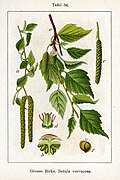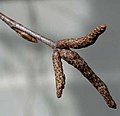User:Jukeboksi/Wiki.study/Natural therapeutics
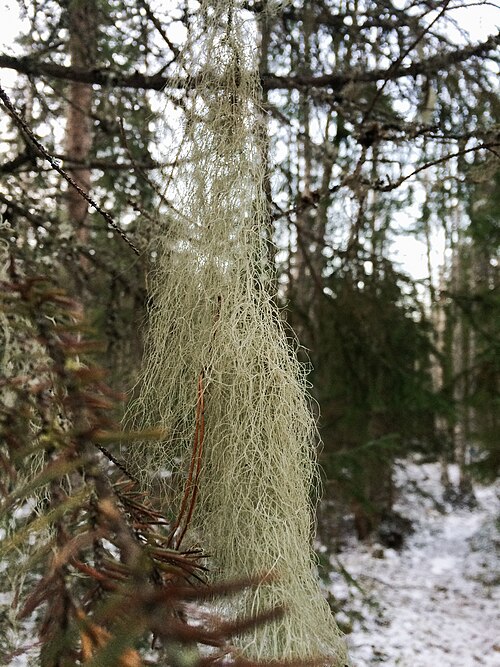
Nature provides us with many healing agents but these are often pushed to the periphery of public knowledge to ensure big pharma profits.
Disclaimer: User:Jukeboksi is not a doctor nor a scientist, but just a concerned citizen.
Why natural therapeutics: In the Spring of 2017 my late dad, Mauri Heikkurinen (RIP) fell ill with Acute myeloid leukemia (AML). I had heard on a cursory level that cannabinoids could help with cancer so I started doing a little research on how CBD oil could help my dad's condition. This natural therapeutics article grew out of that. Dad passed away in September 2017, but I am hopeful that the information in the article can help people find relief from natural therapeutics for their condition.
How is this organized?
The main content is organized alphabetically by illness and then in subheadings alphabetically by natural therapeutic with the linked studies and reporting in reverse chronological order. Some diseases are listed under the group they belong to.
Additionally subsections of #Garden are organized per natural therapeutic alphabetically and contains intra-article links to the illnesses where the natural therapeutic appears to have had an positive effect on.
Allergies[edit | edit source]
Birch pollen allergy[edit | edit source]
Curing birch pollen allergy with birch flowerings[edit | edit source]
Below content is transcluded from User:Jukeboksi/Wiki.study/Natural therapeutics/How I cured my birch pollen allergy in 2000
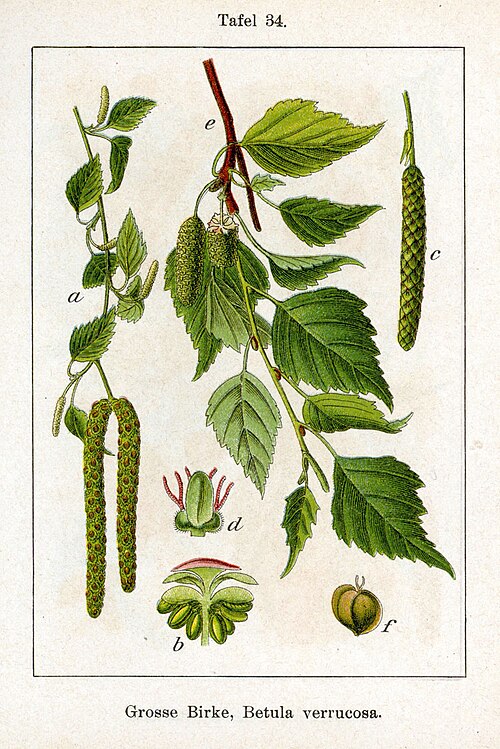
Starting situation: I used to have a bad w:birch w:pollen w:allergy that seemed to just get worse as years went by. I did not have that allergy from birth, but it developed at some stage.
How I cured my birch pollen allergy in 2000
The theorem: In the Spring of 2000, I formulated and tested my theorem that by consuming some birch flowerings I can make the allergy go away, by telling it very loudly enough that you do not make any sense.
The method: I was living in Inner East Helsinki back then and every day when I passed a birch tree I would grab 2-3 flowering bunches and ate them with plenty of water, for the duration that they were present in the trees. This is called w:allergen immunotherapy, though I cannot know if consuming only pollen will do the trick or is there something else in the flowerings that is needed too for the allergy to call it quits.
The taste: Like a carrot where from all sugar, water and orange color had been removed i.e. pretty bad
Contains a side-effect: Occasionally I had perceptions like I was having a slight fever, but the allergy symptoms did not become worse from the consumption of the flowers.
The unknowns
- I do not know precisely which catkins I ate and in which proportions, but looking at the pictures, I ate some of both male and female catkins in all stages.
- I do not know the species of the birch trees, but I could go have a look one day if any of them are still there.
The end result: I have not had any birch pollen allergy starting from Spring of 2001. ~ Jukeboksi (talk)
-
Illustration of Betula pendula (Silver Birch) (rauduskoivu)
-
Betula pendula early-stage male catkins
-
Betula pendula late-stage male flowerings
-
Betula pendula early-stage female flowerings
-
Betula pendula late-stage female flowerings
-
Don't fear the frosty birches, in addition to "allergens" they also contain the cure for the allergy against its pollen when Spring comes
Information on birches w:Birch trees are of the genus Betula. In Finland there are three primary species of birch w:Betula pubescens (w:fi:hieskoivu), w:Betula pendula (w:fi:rauduskoivu) and w:Betula nana (w:fi:vaivaiskoivu) w:List of Betula species
Peanut allergy[edit | edit source]
Oral Immunotherapy in Peanut-Allergic Adults Using Real-World Materials at onlinelibrary.wiley.com, a 2025 open access study, published in w:Allergy (journal)
Reporting
- Daily doses of peanuts could desensitise adults with the allergy at newscientist.com, April 2025 reporting by Carissa Wong
- Daily peanut exposure can desensitise allergic adults, study suggests at theguardian.com
- Deadly peanut allergies could be prevented with simple new method at sciencefocus.com, April 2025 reporting by Hatty Willmoth.
- Study: Eating Peanuts Daily Can Treat Adult Peanut Allergy at verity.news
Alzheimer's[edit | edit source]
Alzheimer's and cannabis[edit | edit source]

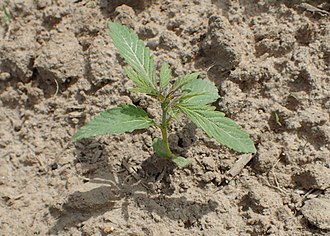
Cannabis has been found beneficial to w:Alzheimer's disease sufferers. This is strongly supported by in-vivo i.e. animal "model" studies, where they cause a similar disease in the test animals and then try different substances on them and see which ones are doing well and which ones are not.
It would seem that w:Tetrahydrocannabinol (THC) is better than any other chemical we know at inhibiting the formation of toxic beta amyloid protein plaque on braincells which causes the deteriation in Alzheimer's disease, but have a look yourself. (own assesment based on abstracts of in-vivo studies and reporting)
See #Cannabis therapeutics for list of other illnesses that cannabis looks to work against.
Scientific research about Alzheimer's and cannabis (in reverse chronology)
- 'Potential and Limits of Cannabinoids in Alzheimer’s Disease Therapy' at ncbi.nlm.nih.gov, a 2021 review published in w:Biology (journal)
- 'Cannabidiol Ameliorates Cognitive Function via Regulation of IL-33 and TREM2 Upregulation in a Murine Model of Alzheimer's Disease' at pubmed.ncbi.nlm.nih.gov, a 2021 study by researchers from w:Augusta University on CBD and and its effects on the w:TREM2 and w:Interleukin 33 proteins in Alzheimer's disease published in w:Journal of Alzheimer's Disease - " Our findings suggest that CBD treatment enhanced IL-33 and TREM2 expression, ameliorated the symptoms of AD, and retarded cognitive decline. " (ending sentence of the abstract)
- 'A Review on Studies of Marijuana for Alzheimer’s Disease – Focusing on CBD, THC' at ncbi.nlm.nih.gov, a 2019 literature review published in the Journal of Pharmacopuncture (JoP) - "These results implied that the CBD components of cannabis might be useful to treat and prevent AD because CBD components could suppress the main causal factors of AD. Moreover, it was suggested that using CBD and THC together could be more useful than using CBD or THC alone." (results section)
- 'Cannabis Therapeutics and the Future of Neurology: Cannabis and Alzheimer Disease (AD)', a 2018 perspectives article published in Frontiers in Integrative Neuroscience.
- A chronic low dose of Δ9-tetrahydrocannabinol (THC) restores cognitive function in old mice' at nature.com, a 2017 joint study by German and Israeli scientists from the w:University of Bonn and the w:Hebrew University of Jerusalem published in w:Nature Medicine.
- 'Cannabis reverses aging processes in the brain, study suggests' at sciencedaily.com, 2017 reporting on the study
- 'Cannabis may offer cure for dementia, study finds' at jpost.com, 2017 reporting on the study
- 'Amyloid proteotoxicity initiates an inflammatory response blocked by cannabinoids' at nature.com, a 2016 open access research article by researchers from the w:Salk Institute and w:University of California, San Diego published in npj Aging and Mechanisms of Disease finds THC reduces beta amyloid proteins in human neurons.
- 'Cannabinoids remove plaque-forming Alzheimer’s proteins from brain cells' at salk.edu, 2016 preliminary reporting on the Salk Institute study.
- 'Safety and Efficacy of Medical Cannabis Oil for Behavioral and Psychological Symptoms of Dementia: An-Open Label, Add-On, Pilot Study' at pubmed.ncbi.nlm.nih.gov[1st seen in 1], a 2016 study published in the w:Journal of Alzheimer's Disease
- 'A Molecular Link Between the Active Component of Marijuana and Alzheimer's Disease Pathology' at ncbi.nlm.nih.gov, a 2008 study published in w:Molecular Pharmacology - Compared to currently approved drugs prescribed for the treatment of Alzheimer's disease, THC is a considerably superior inhibitor of Aβ aggregation, and this study provides a previously unrecognized molecular mechanism through which cannabinoid molecules may directly impact the progression of this debilitating disease. (excerpt from the abstract)
- 'Prevention of Alzheimer's Disease Pathology by Cannabinoids: Neuroprotection Mediated by Blockade of Microglial Activation' at jneurosci.org[1st seen in 2], a 2005 study by Madrid's w:Complutense University and the w:Cajal Institute published in w:Journal of Neuroscience.
- 'Europe: Study: Marijuana Slows Alzheimer's Decline' at mapinc.org[1st seen in 2], 2005 reporting on the study
- 'Marijuana may block Alzheimer's ' at news.bbc.co.uk[1st seen in 2], 2005 reporting on the study
- 'IACM-Bulletin: Science: Cannabinoids reduce the progression of Alzheimer's disease in animals' at cannabis-med.org, 2005 reporting on the study
Links about Alzheimer's disease and cannabis
- 'Cannabis Compounds Found to Remove Toxic Alzheimer’s Proteins From the Brain' at livelovefruit.com - 2018 reporting, updated 2019
- 'Cannabis For Parkinson's And Alzheimer's Diseases -An Interview With Dr. Ethan Russo' at forbes.com, a 2019 interview
- Alzheimer's disease research at en.wikipedia.org has only a few words about cannabis therapeutics and those are very sceptical.
Alzheimer's and turmeric[edit | edit source]
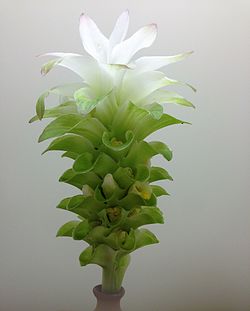
- 'The Effects of Turmeric on Alzheimer’s Patients' at fortunejournals.com, a 2019 study published in the open-access Journal of Food Science and Nutrition Research by Fortune Journals
- 'The effect of curcumin on cognition in Alzheimer’s disease and healthy aging: A systematic review of pre-clinical and clinical studies' at sciencedirect.com, a 2019 systematic review published in w:Brain Research
- 'Optimized Turmeric Extract Reduces β-Amyloid and Phosphorylated Tau Protein Burden in Alzheimer’s Transgenic Mice' at eurekaselect.com[1st seen in 3], a 2012 study published in w:Current Alzheimer Research. The study suggests that turmeric may be useful for Alzheimer's sufferers as it has been shown to inhibit beta amyloid aggregation and secretation in mice.
- 'Effects of turmeric on Alzheimer's disease with behavioral and psychological symptoms of dementia' at ncbi.nlm.nih.gov, a 2012 case report on 3 patients with Alzheimer's disease published in AYU (An International Quarterly Journal of Research in Ayurveda) - The present cases suggest a significant improvement of the behavioral symptoms in the AD with the turmeric treatment, leading to probable benefit of the use of turmeric in individuals with the AD with Behavioral and Psychological Symptoms of Dementia (BPSD). (ending sentence of the abstract)
- 'The effect of curcumin (turmeric) on Alzheimer's disease: An overview' at ncbi.nlm.nih.gov, a 2008 overview article published in the w:Annals of Indian Academy of Neurology
Links about Alzheimer's disease and turmeric
Alzheimer's and ginger[edit | edit source]

Ginger may improve brain functioning and protect against Alzheimer's disease [1st seen in 4]
- 'Ginger, a Possible Candidate for the Treatment of Dementias?' at ncbi.nlm.nih.gov, a 2021 literature review published in w:Molecules (journal)
- 'Ginger components as new leads for the design and development of novel multi-targeted anti-Alzheimer’s drugs: a computational investigation' at ncbi.nlm.nih.gov[1st seen in 4], a 2014 study published in w:Drug Design, Development and Therapy
- 'Protective effects of ginger root extract on Alzheimer disease-induced behavioral dysfunction in rats' at pubmed.ncbi.nlm.nih.gov[1st seen in 4], a 2013 study published in w:Rejuvenation Research
- 'Inhibition of acetylcholinesterase activities and some pro-oxidant induced lipid peroxidation in rat brain by two varieties of ginger (Zingiber officinale)' at pubmed.ncbi.nlm.nih.gov[1st seen in 4], a 2012 study published in Experimental and Toxicologic Pathology
Antibiotics from nature[edit | edit source]
Antibiotic blackberries[edit | edit source]

Blackberries kill antibiotic resistant staphylococcus aureus bacteria[1]. Irish teen awarded prize for discovery.[2]
Antibiotic cannabis leaves[edit | edit source]
Cannabis leaves found effective against antibiotic resistant bacteria.[3]
Studies about antibiotic cannabis
- 'In vitro antibacterial activity of Cannabis sativa leaf extracts to some selective pathogenic bacterial strains', a 2014 open-access research paper
Links about antibiotic cannabis
Antibiotic thyme[edit | edit source]

Thyme contains w:thymol, which is a natural antibiotic. Oil of thyme, the essential oil of common thyme (w:Thymus vulgaris), contains 20–54% thymol and other substances. (Wikipedia)
- 'Thyme Essential Oil for Pain Relief', a 2018 LiveLoveFruit.com article
Autism[edit | edit source]
Autism and cannabis[edit | edit source]
- Extensive compendium of research about autism and cannabis compiled by calgarycmmc.com
- 'Is Marijuana the World's Most Effective Treatment for Autism?' at newsweek.com by Debra Kamin in 2018
- CBD Medical Uses • Health • Science 'Why People Use CBD for Autism' at whatiscbd.com
Autoimmune diseases[edit | edit source]
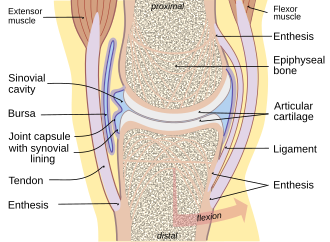
Terminology
- w:Autoimmunity is the system of immune responses of an organism against its own healthy cells, tissues and other body normal constituents.
- w:Autoimmune disease is a condition arising from an abnormal w:immune response to a functioning body part.
- w:Rheumatology (Greek ῥεῦμα, rheûma, flowing current) is a branch of medicine devoted to the w:medical diagnosis and w:therapy of rheumatic diseases.
- w:Rheumatism[4] or rheumatic disorders are conditions causing w:chronic, often intermittent pain affecting the w:joints or w:connective tissue.
- w:Arthritis is a term often used to mean any disorder that affects w:joints (Wikipedia)
- w:Rheumatoid arthritis (RA) is a long-term w:autoimmune disorder that primarily affects w:synovial joints.
- w:Rheumatoid factor (RF) is the w:autoantibody that was first found in w:rheumatoid arthritis. It is defined as an w:antibody against the w:Fragment crystallizable region portion of w:IgG and different RFs can recognize different parts of the IgG-Fc.[5] RF and IgG join to form w:immune complexes that contribute to the w:disease process.[6] (Wikipedia)
- w:Osteoarthritis (OA) is a type of degenerative w:joint disease that results from breakdown of articular joint cartilage and underlying w:bone.
- w:Synovial joint, also known as diarthrosis, joins bones or cartilage with a fibrous w:joint capsule that is continuous with the w:periosteum of the joined bones, constitutes the outer boundary of a synovial cavity, and surrounds the bones' articulating surfaces. (Wikipedia)
Lists
- w:List of autoimmune diseases is a list of w:autoimmune diseases is categorized by w:organ and tissue type to help locate diseases that may be similar.
Organizations
- w:European Alliance of Associations for Rheumatology is a European non-governmental organization which represents the people with arthritis/rheumatism, health professional and scientific societies of rheumatology of all the European nations. (Wikipedia)
- w:International League of Associations of Rheumatology is an international body of the associations of Rheumatologists from around the world.
- w:Arthritis Foundation is a nonprofit organization that is dedicated to addressing the needs of people living with arthritis in the United States.
- w:Arthritis Australia - arthritisaustralia.com.au - Australia
- w:Versus Arthritis - versusarthritis.org - UK
- Arthritis Consumer Experts at jointhealth.org - Canada
- Spondylitis Association of America at spondylitis.org- U.S.A.
- The Arthritis Society at arthritis.ca – Canada
- w:The Swedish Rheumatism Association - reumatiker.se- Sweden
Autoimmune diseases and cannabis[edit | edit source]
Cannabis helps with many autoimmune diseases due to its anti-inflammatory and other properties.
Studies about autoimmune diseases and cannabis
- 'Cannabis and Autoimmunity: Possible Mechanisms of Action' at ncbi.nlm.nih.gov, a Jul 2021 review published in w:ImmunoTargets & Therapy - In this review, we summarized the main mechanisms of action of medical cannabis plant especially regarding the immune system and the endocannabinoid system, looking at preliminary clinical data in three most important autoimmune diseases of three different specialities: rheumatoid arthritis, multiple sclerosis and inflammatory bowel disease.
- 'Cannabis and Cannabinoids in the Treatment of Rheumatic Diseases' at ncbi.nlm.nih.gov, a Jan 2020 mini-review published in the w:Rambam Maimonides Medical Journal - covers Fibromyalgia and rheumatoid arthritis, osteoarthritis and systemic sclerosis.
Research presentations
- 'Medical Cannabis: What Research is Revealing' 1 hr video at arthritis.ca slides presented by Dr. Jason McDougall, Professor, Nova Scotia and moderated by Dr. Siân Bevan, Chief Science Officer of the Arthritis Society on 2021-09-15. Dr. McDougall's work was kindly funded by the Arthritis Society of Canada.[1st seen in 5]
Links about autoimmune diseases and cannabis
Rheumatoid arthritis and Osteoarthritis[edit | edit source]
- 'Characterisation of the cannabinoid receptor system in synovial tissue and fluid in patients with osteoarthritis and rheumatoid arthritis' at ncbi.nlm.nih.gov, a 2008 study published in w:Arthritis Research & Therapy - Results: CB1 and CB2 protein and RNA were present in the synovia of OA and RA patients. Cannabinoid receptor stimulation of fibroblast-like cells from OA and RA patients produced a time-dependent phosphorylation of extracellular signal-regulated kinase (ERK)-1 and ERK-2 which was significantly blocked by the CB1 antagonist SR141716A. The endocannabinoids anandamide (AEA) and 2-arachidonyl glycerol (2-AG) were identified in the synovial fluid of OA and RA patients. However, neither AEA nor 2-AG was detected in synovial fluid from normal volunteers. FAAH was active in the synovia of OA and RA patients and was sensitive to inhibition by URB597 (3'-(aminocarbonyl) [1,1'-biphenyl]-3-yl)-cyclohexylcarbamate).
Rheumatoid arthritis[edit | edit source]
Links
- 'RA: Best and Worst Supplements and Herbs' at webmd.com mentions w:Fish oil, w:borage seed oil, w:turmeric, w:boswellia, w:ginger and w:green tea extract, w:probiotics.
Rheumatoid arthritis and cannabis[edit | edit source]
Cannabis helps with Rheumatoid arthritis.
Studies about rheumatic diseases and cannabis
- 'Cannabidiol (CBD): a killer for inflammatory rheumatoid arthritis synovial fibroblasts' at nature.com, a 2020 study published in Cell Death & Disease
- 'New Arthritis Foundation Guidelines On CBD Use Could Be First Of Many More To Come ' at athmjournal.com (pubmed link), a Feb 2020 article by Murdoc Khaleghi published in w:Alternative Therapies in Health and Medicine
- 'Joints for joints: cannabinoids in the treatment of rheumatoid arthritis' at journals.lww.com, a 2019 review published in Current Opinion in Rheumatology (w:Current Opinion (Lippincott Williams & Wilkins))
- 'The endocannabinoid system in pain and inflammation: Its relevance to rheumatic disease', a 2017 article
- 'Expression of cannabinoid receptor 2 and its inhibitory effects on synovial fibroblasts in rheumatoid arthritis ' at pubmed.ncbi.nlm.nih.gov, a 2014 comparative study published in w:Rheumatology (journal)
Links about Rheumatoid arthritis and cannabis
- 'Finally! A Promising UK Study On Cannabis For Arthritis' at herb.co, a 2016 health reporting
- '57% of Arthritis Patients Have Tried Cannabis. 90% Found It Helped' at leafly.com, a June 2019 article by Alexa Peters
- 'Cannabis for Arthritis: How One Plant is Being Used to Repair Arthritic Joints at livelovefruit.com
- 'Woman who uses cannabis to treat arthritis urges doctors to prescribe to patients in need' at newshub.co.nz, a 2019 article
Past links about rheumatoid arthritis and cannabis
- 'Cannabis Could Be Reversing Damage to Arthritic Joints' archived version at web.archive.org originally at ehealthmagz.com, was a Oct 2018 article
Rheumatoid arthritis and ginger[edit | edit source]
“Gingerol seems to be effective in an animal model of rheumatoid arthritis.[7]”
Studies about Rheumatoid Arthritis and ginger
- 'Comparative Effects of Two Gingerol-Containing Zingiber officinale Extracts on Experimental Rheumatoid Arthritis' at ncbi.nlm.nih.gov, a 2009 study published in the w:Journal of Natural Products - Conclusion: Ginger is now the second member of the Zingiberaceae family demonstrated to have profound antiarthritic efficacy in the SCW-induced model of rheumatoid arthritis. The antiarthritic effects of ginger are particularly intriguing as these studies suggest that the antiarthritic bioactivity of this Zingiberaceae involves additive and/or synergistic effects of multiple components, including, but not limited to, the gingerols.
About Rheumatoid arthritis in Finnish / Nivelreumasta suomeksi[edit | edit source]
- '8 yrttiä, joita käyttää niveltulehduksessa'' at askelterveyteen.com (8 herbs to use in joint case of joint inflammation) lists aloe vera, uncaria tomentosa, eucalyptus, ginger, turmeric, Arnica angustifolia, willow and green tea
Osteoarthritis[edit | edit source]
- 'G Protein-Coupled Receptors in Osteoarthritis' at ncbi.nlm.nih.gov, a 2021 summary article published in w:Frontiers in Endocrinology on w:G protein-coupled receptors in Osteoarthritis
Note: Cannabinoid receptors are G protein-coupled as far as I know
Lupus and cannabis[edit | edit source]
Cannabis helps with Systemic lupus erythematosus
Coeliac disease and cannabis[edit | edit source]
Cannabis helps with Coeliac disease.
Psoriasis and cannabis[edit | edit source]
You could also be looking for dermatitis, also known as eczema.
Cannabis helps with Psoriasis and when applied externally.
- https://herb.co/learn/cbd-lotion-psoriasis/
- https://herb.co/guides/cbd-oil-psoriasis-eczema/
- https://hightimes.com/health/treat-psoriasis-with-cannabis/
Bone diseases[edit | edit source]
- Osteoarhritis is an autoimmune bone disease
- #Osteosarcoma is a bone cancer
Cancers[edit | edit source]
- w:List of unproven and disproven cancer treatments takes a very negative stance on e.g. healing with cannabis.
Cancers and turmeric[edit | edit source]
Curcumin has been found to have anti-cancer properties. Curcumin interferes with cancer via multiple cell signaling pathways, including cell cycle, apoptosis, proliferation, survival, invasion, angiogenesis, metastasis and inflammation[8].
- Study: 'Curcumin and Cancer Cells: How Many Ways Can Curry Kill Tumor Cells Selectively?' at link.springer.com
- General info: Turmeric and cancers article by Cancer Research UK
Cancers and cannabis[edit | edit source]
Key things everyone needs to know about cancers and cannabis[edit | edit source]
Warning: Smoking the cannabis as the method of cannabinoid delivery the smoke contains quite a few carcinogenic substances i.e. cancer inducing substances. See the section administering cannabis for alternatives to smoking it.
Internet is rife with stories about winning the battle against cancer with the help of phytocannabinoids. What does the science say?
Cannabis is...
- Anti-proliferative - cannabis is against tumor growth [9]
- Anti-metastatic - cannabis is against cancer spreading to other parts in the body because of metastatic activity[9]
- Anti-angiogenetic - cannabis is against new blood vein growth to tumor[9]
- Apoptotic - cannabis causes cancer cells to programmedly kill themselves via Apoptosis. [9]
- Pain relief - cannabis works very well against the somatic and nonsomatic pains brought on by cancer.
- Appetite stimulator - cannabis helps maintain a good appetite.
- Anti-nauseatic - cannabis helps with the chemotherapy-induced nausea and vomiting if you receive chemotherapy. World's first study of cannabis for chemotherapy's negative effects is underway in Australia. [10] [11]
Phytocannabinoids are harmless to healthy cannabinoid receptor containing cells.
- Everything You Need To Know About Cannabis And Cancer Treatment, a 2017 article at herb.co
- These Are The 4 Ways Cannabis Kills Cancer, a 2016 article at herb.co
Scientific works about cannabis and cancers in general[edit | edit source]
- 'The Endocannabinoid System as a Target in Cancer Diseases: Are We There Yet?' at frontiersin.org a 2019 peer-reviewed review article published in Frontiers in Pharmacology, a journal by w:Frontiers Media
- 'The heterogeneity and complexity of Cannabis extracts as antitumor agents' at Oncotarget.com, a 2019 research paper published in w:Oncotarget
- 'Cannabidiol as potential anticancer drug' at pubmed.ncbi.nlm.nih.gov, a 2017 review published in the w:British Journal of Clinical Pharmacology
- 'Integrating cannabis into clinical cancer care' at ncbi.nlm.nih.gov, a 2016 scientific article by D.I. Abrams, MD, published in w:Current Oncology
- 'Anticancer mechanisms of cannabinoids' at ncbi.nlm.nih.gov, a 2016 paper published in w:Current Oncology
- 'Integrating cannabis into clinical cancer care' at ncbi.nlm.nih.gov, a 2016 study published in the journal w:Current Oncology
- 'Cannabis-derived substances in cancer therapy--an emerging anti-inflammatory role for the cannabinoids' at ncbi.nlm.nih.gov[1st seen in 6], a 2010 review, published in Current Clinical Pharmacology
Links about cannabis and cancer in general[edit | edit source]
Ongoing and upcoming cannabis and cancer
- 'Israeli Cannabis Outfit Cannbit Launches Cancer Study', a 2019 news item on calcalistech.com. The study will involve molecules found effective in fighting melanoma, neuroblastoma, and Glioblastoma.
"Official" information
- 'Marijuana and Cancer' by the American Cancer Society
- National Cancer Institute of USA on cancers and cannabis (health professional version)
- National Cancer Institute of USA on cancers and cannabis (patient version)
Cannabis and cancers advocacy
- A compendium of research regarding cancers and cannabis at calgarycmmc.com
- Cannabis Research A to Z, the letter 'C' at calgarycmmc.com
- Exposing The Truth: Links with abstracts to 123 scientific articles on cannabis and cancers
- http://www.healedbycannabis.com/ Healed by Cannabis website] by a cancer survivor David Triplett who healed his skin cancer with cannabis oil
Testimonies about cannabis and cancer
Cancer surviving cases with cannabis
Learn from videos by experts in phytocannabinoid treatment of cancers
People:
- Dr. Cristina Sánchez is a molecular biology research scientist who did her doctorate on cannabinoids and cancers. She is a leader in researching the anti-cancer qualities of cannabinoids. She works at the w:Complutense University of Madrid
- Dr. Manuel Guzmán also works as a molecular biology researcher on researching the potential of cannabis as a cancer medication in the Complutense University of Madrid.
- Dr. Wai Liu works on researching medical cannabis for cancer (among other things) at the w:St George's, University of London.
Videos
- Dr. Cristina Sanchez interview where she expains how apoptosis makes cancer cells kill themselves
- Dr. Cristina Sanchez on how cannabinoids work against cancers
- Dr. Cristina Sanchez at Cannafest Prague 2015
- Dr. Cristina Sanchez lecture in Australia (no slideshow shots, sorry)
See also: Cancers and turmeric (intra-article link)
Chemotherapy and cannabis[edit | edit source]
- 'Study: CBD From Marijuana Plus Chemotherapy Tripled Cancer Survival Rates In Mice', a 2018 news item on Forbes.com
Adenocarcinoma[edit | edit source]
Adenocarcinoma is a type of cancerous tumor that can occur in several parts of the body. (Wikipedia)
Links
- 'Flavonoids May Be A Cancer-Fighter In Cannabis', a 2019 article on adenocarcinomas and flavonoids of cannabis at RXLeaf.com
Brain cancer[edit | edit source]

A glioma is a type of tumor that starts in the glial cells of the brain or the spine. (Wikipedia)
w:Astrocytomas are a type of w:brain tumor. They originate in a particular kind of glial cells, star-shaped brain cells in the w:cerebrum called w:astrocytes. This type of tumor does not usually spread outside the brain and spinal cord and it does not usually affect other organs. Astrocytomas are the most common w:glioma and can occur in most parts of the brain and occasionally in the spinal cord. (Wikipedia on 2020-07-16)
A blastoma is a type of cancer, more common in children, that is caused by malignancies in precursor cells. (Wikipedia)
A Glioblastoma is the most aggressive form of brain cancer, but it may potentially be treated with cannabis.[12]
Brain cancer and cannabis[edit | edit source]
In 2018 Insys Therapeutics announced the the FDA has given CBD an orphan drug designation (ODD) to CBD for treating gliomas.[13]
Studies about brain tumors and cannabis
- 'Inhalant Cannabidiol Inhibits Glioblastoma Progression Through Regulation of Tumor Microenvironment' at pubmed.ncbi.nlm.nih.gov, a 2021 in-vivo study on the effects of CBD on glioblastomas published in w:Cannabis and Cannabinoid Research[1st seen in 7]
- 'Cannabigerol Is a Potential Therapeutic Agent in a Novel Combined Therapy for Glioblastoma' at proquest.com[1st seen in 8], a 2021 study published in w:Cell (journal) regarding the efficacy of combining #CBG (w:Cannabigerol) with other medication against gliomas.
- 'Cannabis Therapeutics and the Future of Neurology: Cannabis and Brain Tumors' at FrontiersIn.org, a 2018 perspective article published in Frontiers in Integrative Neuroscience by w:Frontiers Media
- 'Opposite changes in cannabinoid CB1 and CB2 receptor expression in human gliomas' at ncbi.nlm.nih.gov[1st seen in 6], a 2010 comparative study, published in w:Neurochemistry International
- 'The expression level of CB1 and CB2 receptors determines their efficacy at inducing apoptosis in astrocytomas' at ncbi.nlm.nih.gov[1st seen in 6], a 2010 study published in w:PLOS One on w:astrocytomas and cannabis receptors
- 'Down-regulation of tissue inhibitor of metalloproteinases-1 in gliomas: a new marker of cannabinoid antitumoral activity?' at ncbi.nlm.nih.gov[1st seen in 6], a 2009 clinical trial, published in w:Neuropharmacology (journal)
- 'Predominant CB2 receptor expression in endothelial cells of glioblastoma in humans' at ncbi.nlm.nih.gov[1st seen in 6], a 2009 study, published in w:Brain Research Bulletin
- 'Amphiregulin is a factor for resistance of glioma cells to cannabinoid-induced apoptosis' at ncbi.nlm.nih.gov[1st seen in 6], a 2009 study, published in w:Glia (journal)
- 'Cannabinoid action induces autophagy-mediated cell death through stimulation of ER stress in human glioma cells' at ncbi.nlm.nih.gov[1st seen in 6], a 2009 study, published in w:Journal of Clinical Investigation
- 'Cannabinoids as potential new therapy for the treatment of gliomas' at ncbi.nlm.nih.gov[1st seen in 6], a 2008 review, published in Expert review on neurotherapies
- 'High concentrations of cannabinoids activate apoptosis in human U373MG glioma cells' at ncbi.nlm.nih.gov[1st seen in 6], a 2008 study published in w:Journal of Neuroscience Research
- 'Cannabinoids inhibit glioma cell invasion by down-regulating matrix metalloproteinase-2 expression' at ncbi.nlm.nih.gov[1st seen in 6], a 2008 study, published in w:Cancer Research (journal)
- 'Cannabinoids and gliomas' at ncbi.nlm.nih.gov[1st seen in 6], a 2007 review, published in w:Molecular Neurobiology (journal)
- 'Cannabinoids induce glioma stem-like cell differentiation and inhibit gliomagenesis' at ncbi.nlm.nih.gov[1st seen in 6], a 2007 study, published in w:Journal of Biological Chemistry
- 'Cannabinoid receptors in human astroglial tumors' at ncbi.nlm.nih.gov[1st seen in 6], a 2006 study published in w:Journal of Neurochemistry
- 'The non-psychoactive cannabidiol triggers caspase activation and oxidative stress in human glioma cells' at ncbi.nlm.nih.gov[1st seen in 6], a 2006 study published in w:Cellular and Molecular Life Sciences
- 'Cannabidiol inhibits human glioma cell migration through a cannabinoid receptor-independent mechanism' at ncbi.nlm.nih.gov[1st seen in 6], 2005 study, published in w:British Journal of Pharmacology
- 'Arachidonylethanolamide induces apoptosis of human glioma cells through vanilloid receptor-1' at ncbi.nlm.nih.gov[1st seen in 6], a 2004 study, published in w:Journal of Neuropathology & Experimental Neurology
- 'Cannabinoids inhibit the vascular endothelial growth factor pathway in gliomas' at ncbi.nlm.nih.gov[1st seen in 6], a 2004 study, published in w:Cancer Research (journal)
- 'Hypothesis: cannabinoid therapy for the treatment of gliomas?' at ncbi.nlm.nih.gov[1st seen in 6], a 2004 review, published in w:Neuropharmacology (journal)
- 'Antitumor effects of cannabidiol, a nonpsychoactive cannabinoid, on human glioma cell lines' at ncbi.nlm.nih.gov[1st seen in 6], a 2004 study, published in w:Journal of Pharmacology and Experimental Therapeutics
- 'Up-regulation of cyclooxygenase-2 expression is involved in R(+)-methanandamide-induced apoptotic death of human neuroglioma cells' at ncbi.nlm.nih.gov[1st seen in 6], a 2004 study, published in w:Molecular Pharmacology
- 'Inhibition of glioma growth in vivo by selective activation of the CB(2) cannabinoid receptor' at ncbi.nlm.nih.gov[1st seen in 6], a 2001 study published in w:Cancer Research (journal)
- 'Delta9-tetrahydrocannabinol induces apoptosis in C6 glioma cells' at ncbi.nlm.nih.gov[1st seen in 6], a 1998 study, published in w:FEBS Letters
Links about brain cancer and cannabis
- Extensive compendium of research about brain cancer and cannabis at calgarycmmc.com
- https://herb.co/news/health/taylor-rehmeyer/
Breast cancer[edit | edit source]
Breast cancer and cannabis[edit | edit source]
Breast cancer and dandelion[edit | edit source]
- Combined dandelion extract and all-trans retinoic acid induces cytotoxicity in human breast cancer cells at nature.com, a 2023 study published in w:Scientific Reports.
Breast cancer and frankincense[edit | edit source]
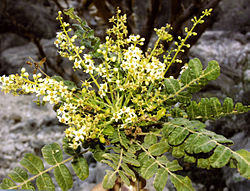
Boswellia is a genus of trees in the order Sapindales, known for their fragrant resin. The biblical incense w:frankincense was an extract from the resin of the tree Boswellia sacra, and is now produced also from B. frereana. (Wikipedia)
Scientific articles about frankincense healing
- 'Boswellia sacra essential oil induces tumor cell-specific apoptosis and suppresses tumor aggressiveness in cultured human breast cancer cells', a 2011 in vitro study
Breast cancer and ginger[edit | edit source]
“Gingerol has been investigated w:in vitro for its effect on cancerous tumors of the bowel,[14][15] breast tissue,[16] ovaries,[17] and pancreas,[18] with positive results.”
Cervical cancer[edit | edit source]
Cervical cancer and cannabis[edit | edit source]
Colon cancer[edit | edit source]
Colon cancer and cannabis[edit | edit source]
Colon cancer and ginger[edit | edit source]
“Gingerol has been investigated w:in vitro for its effect on cancerous tumors of the bowel,[14][15] breast tissue,[16] ovaries,[17] and pancreas,[18] with positive results.”
Colon cancer and dandelion root[edit | edit source]
Studies
- Dandelion root extract suppressed gastric cancer cells proliferation and migration through targeting lncRNA-CCAT1 at sciencedirect.com, a 2017 study published in w:Biomedicine & Pharmacotherapy. In this study, we show that dandelion root extract (DRE) specifically and effectively suppresses proliferation and migration in human gastric cells without inducing toxicity in noncancerous cells. Long noncoding RNAs (lncRNAs) are known to promote tumorigenesis in many cancer types. Here, we showed that the lncRNA colon cancer-associated transcript-1 (CCAT1) was down-regulated in dandelion-treated GC cells. (from the abstract)
The Dandelion Root Project at University of Windsor, Ontario has studied dandelion root since 2009 and they state on on their website:
“Since the commencement of this project, we have been able to successfully assess the effect of a simple water extract of dandelion root in various human cancer cell types, in the lab and we have observed its effectiveness against human T cell leukemia, chronic myelomonocytic leukemia, pancreatic and colon cancers, with no toxicity to non-cancer cells. Furthermore, these efficacy studies have been confirmed in animal models (mice) that have been transplanted with human colon cancer cells.[19]”
Langerhans cell sarcoma[edit | edit source]
Langerhans cell sarcoma and cannabis[edit | edit source]
Langerhans cell sarcoma is extremely rare.
Leukemia[edit | edit source]
There are 2 main types of Leukemia:
- Myeloid leukemia (of the bone marrow)
- Lymphoid leukemia (of the lymphatic node)
Leukemia and cannabis[edit | edit source]
Links about Lymphoid and Myeloid leukemia and cannabis
- Dronabinol (synthetic THC) has preferential antileukemic activity in acute lymphoblastic and myeloid leukemia with lymphoid differentiation patterns
- Enhancing the Activity of Cannabidiol and Other Cannabinoids In Vitro Through Modifications to Drug Combinations and Treatment Schedules, a 2013 study published in the journal Anticancer Research
Leukemia and ginger[edit | edit source]
“Gingerol and its analogues have a favourable toxicity profile, but are cytotoxic towards a range of cancer cell lines including blood cancer and lung cancer.[20]”
Lymphoid leukemia and cannabis[edit | edit source]
Links about Lymphoid leukemia and cannabis
- https://ocgreenrelief.org/medical-marijuana/cannabis-oil-acute-leukemia-2
- http://truemedmd.com/2014/06/cannabis-oil-acute-leukemia/
T cell leukemia and dandelion root[edit | edit source]
The Dandelion Root Project at University of Windsor, Ontario has studied dandelion root since 2009 and they state on on their website:
“Since the commencement of this project, we have been able to successfully assess the effect of a simple water extract of dandelion root in various human cancer cell types, in the lab and we have observed its effectiveness against human T cell leukemia, chronic myelomonocytic leukemia, pancreatic and colon cancers, with no toxicity to non-cancer cells. Furthermore, these efficacy studies have been confirmed in animal models (mice) that have been transplanted with human colon cancer cells.[19]”
Myeloid leukemia and cannabis[edit | edit source]
Links about Myeloid leukemia and cannabis
- Extensive compendium of research on leukemia and cannabis at calgarycmmc.com
- https://www.leafscience.com/2013/10/14/cannabinoids-destroy-leukemia-cells-new-study-finds/ (as of 2021-10-11 does not load)
- https://medijane.co.za/disease-index/will-marijuana-cure-cancer/acute-myeloid-leukemia-aml-cannabis/
Chronic myelomonocytic leukemia and dandelion root[edit | edit source]
Studies
- Efficient induction of extrinsic cell death by dandelion root extract in human chronic myelomonocytic leukemia (CMML) cells at pubmed.ncbi.nlm.nih.gov, a 2012 study published in w:PLOS One. The results from this study indicate that Dandelion Root Extract (DRE) is able to efficiently and selectively induce apoptosis and autophagy in these cell lines in a dose and time dependent manner, with no significant toxicity on non-cancerous peripheral blood mononuclear cells. More importantly, we observed early activation of initiator caspase-8, which led to mitochondrial destabilization and the induction of autophagy, suggesting that DRE acts through the extrinsic pathway of apoptosis. (from the abstract)
The Dandelion Root Project at University of Windsor, Ontario has studied dandelion root since 2009 and they state on on their website:
“Since the commencement of this project, we have been able to successfully assess the effect of a simple water extract of dandelion root in various human cancer cell types, in the lab and we have observed its effectiveness against human T cell leukemia, chronic myelomonocytic leukemia, pancreatic and colon cancers, with no toxicity to non-cancer cells. Furthermore, these efficacy studies have been confirmed in animal models (mice) that have been transplanted with human colon cancer cells.[19]”
Liver cancer[edit | edit source]
Liver cancer and cannabis[edit | edit source]
Lung cancer[edit | edit source]
Lung cancer and cannabis[edit | edit source]
Laboratory and mice studies seem to indicate that THC can slow down the growth of lung cancer tumours from growing by binding to the same receptors as epidermal growth factor (EGF): the epidermal growth factor receptors (EGFR).
Links to studies about lung cancer and cannabis '
- An article on a 2007 study on THC against lung cancer on sciencedaily.com
- Study: "Δ-9 Tetrahydrocannabinol inhibits growth and metastasis of lung cancer." presented at the 2007 AACR Annual Meeting
- 'Striking lung cancer response to self-administration of cannabidiol: A case report and literature review'
Compendiums of information on lung cancer and cannabis
Lung cancer and cannabis in the media
- Marijuana Compound May Fight Lung Cancer at abcnews.go.com
- Patient taking CBD oil found to have significant shrinking of the tumor (2019 article)
Lung cancer and ginger[edit | edit source]
“Gingerol and its analogues have a favourable toxicity profile, but are cytotoxic towards a range of cancer cell lines including blood cancer and lung cancer.[21]”
Lymphoma[edit | edit source]
Hodgkin's lymphoma is a type of lymphoma in which cancer originates from a specific type of white blood cells called lymphocytes. (Wikipedia)
- 'Potentiation of cannabinoid-induced cytotoxicity in mantle cell lymphoma through modulation of ceramide metabolism ' at ncbi.nlm.nih.gov[1st seen in 6], a 2009 study, published in w:Molecular Cancer Research
- 'Expression of cannabinoid receptors type 1 and type 2 in non-Hodgkin lymphoma: growth inhibition by receptor activation ' at ncbi.nlm.nih.gov[1st seen in 6], a 2008 study, published in w:International Journal of Cancer
- 'Cannabinoid receptor-mediated apoptosis induced by R(+)-methanandamide and Win55,212-2 is associated with ceramide accumulation and p38 activation in mantle cell lymphoma' at ncbi.nlm.nih.gov[1st seen in 6], a 2006 study, published in w:Molecular Pharmacology
- 'Cannabinoid receptor ligands mediate growth inhibition and cell death in mantle cell lymphoma ' at ncbi.nlm.nih.gov[1st seen in 6], a 2005 comparative study, published in w:FEBS Letters
Lymphoma and cannabis[edit | edit source]
Used to exist There was an article at herb.co Hodgkin’s Lymphoma: Does Cannabis Help? herb.co at stored in archive.org in Feb 2019. Article existed from June 2017 to at least February 2019. Found non-existent in Dec 2021, no information on why it was removed from the herb.co website.
Oral cancer[edit | edit source]
Oral cancer and cannabis[edit | edit source]
Osteosarcoma[edit | edit source]
w:Osteosarcoma is a bone cancer.
Osteosarcoma and cannabis[edit | edit source]
- Cannabinoids show promise for cancer patients local reporting in the Longmont Times-Call at timescall.com. "Braden Stevenson, a 17-year-old living in Longmont, was diagnosed with osteosarcoma in 2016..."
Used to be
- There used to be an article www.rxleaf.com/post/12004/colorado-teen-sent-home-to-die-from-bone-cancer-but-cannabis-got-him-back-to-school. Link was found 404 and search on website didn't find it elsewhere. The removal of this content may be due to the kid's mother later stressing that cannabis didn't heal his son.[contacted 1]
Ovarian cancer[edit | edit source]
Ovarian cancer and cannabis[edit | edit source]
Links to studies about ovarian cancer and cannabis
- 'KY Hemp-induced Modulation of Ovarian Cancer Cell Metastasis', a 2018 abstract presented at the Experimental Biology meeting. Inverse.com article on the study
Links to information about ovarian cancer and cannabis
Ovarian cancer and frankincense[edit | edit source]
Links to articles about frankincense healing '
- 'Frankincense Effective in Killing Ovarian Cancer Cells, Study' reporting at www.universityherald.com (2013 news item) and reported again by 2019 popular article 'Frankincense found to outperform chemo in killing Ovarian Cancer cells' on GetHolisticHealth.com
Ovarian cancer and ginger[edit | edit source]
“Gingerol has been investigated w:in vitro for its effect on cancerous tumors of the bowel,[14][15] breast tissue,[16] ovaries,[17] and pancreas,[18] with positive results.”
Pancreatic cancer[edit | edit source]
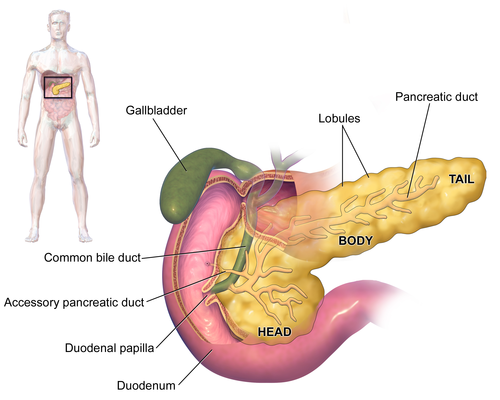
Pancreatic cancer and cannabis[edit | edit source]
- Medical cannabis extract could help pancreatic cancer patients live longer, early study suggests an 2019 article in the Independent
Studies about pancreatic cancer and cannabis
- 'GPR55 signalling promotes proliferation of pancreatic cancer cells and tumour growth in mice, and its inhibition increases effects of gemcitabine', a 2018 study published in Oncogene. Forbes.com news item on the study 'Study: CBD From Marijuana Plus Chemotherapy Tripled Cancer Survival Rates In Mice'
- 'Cannabinoids induce apoptosis of pancreatic tumor cells via endoplasmic reticulum stress-related genes' at ncbi.nlm.nih.gov[1st seen in 6], a 2006 study published in w:Cancer Research (journal)
- 'Cannabinoid derivatives induce cell death in pancreatic MIA PaCa-2 cells via a receptor-independent mechanism' at ncbi.nlm.nih.gov[1st seen in 6], a 2006 study, published in w:FEBS Letters
Pancreatic cancer and ginger[edit | edit source]

“Gingerol has been investigated w:in vitro for its effect on cancerous tumors of the bowel,[14][15] breast tissue,[16] ovaries,[17] and pancreas,[18] with positive results.”
Pancreatic cancer and dandelion root[edit | edit source]
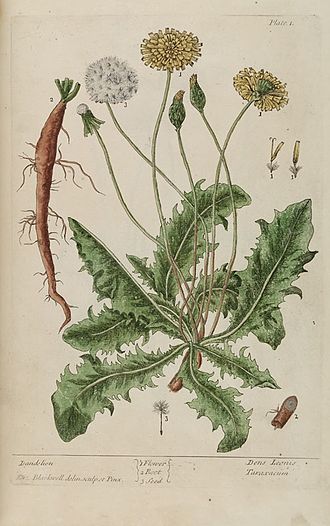
Hand coloured print, plate 1 of Dens Leonis in A Curious Herbal, 1737 by Elizabeth Blackwell
The Dandelion Root Project at University of Windsor, Ontario has studied dandelion root since 2009 and they state on on their website:
“Since the commencement of this project, we have been able to successfully assess the effect of a simple water extract of dandelion root in various human cancer cell types, in the lab and we have observed its effectiveness against human T cell leukemia, chronic myelomonocytic leukemia, pancreatic and colon cancers, with no toxicity to non-cancer cells. Furthermore, these efficacy studies have been confirmed in animal models (mice) that have been transplanted with human colon cancer cells.[19]”
Studies about pancreatic cancer and dandelion root
- 'Selective induction of apoptosis and autophagy through treatment with dandelion root extract in human pancreatic cancer cells' at ncbi.nlm.nih.gov, a 2012 study published in Pancreas (journal).
Prostate cancer[edit | edit source]
Prostate cancer and cannabis[edit | edit source]
Cannabis helps with prostate cancer.
- Extensive compendium of research on prostate cancer and cannabis at calgarycmmc.com
- https://cannabishealthradio.com/podcast/blog/2017/09/18/episode-217-his-incurable-prostate-cancer-has-been-cleared-with-the-use-of-cannabis-oil?rq=episode%20217
Prostate cancer and dandelion root[edit | edit source]
- 'Evaluation of aqueous extracts of Taraxacum officinale on growth and invasion of breast and prostate cancer cells', a 2008 study
Skin cancer[edit | edit source]
Skin cancer and cannabis[edit | edit source]
- Extensive compendium of research on skin cancer and cannabis at calgarycmmc.com
- https://www.theroc.us/researchlibrary/Differential%20role%20of%20cannabinoids%20in%20the%20pathogenesis%20of%20skin%20cancer.pdf
Melanoma[edit | edit source]
Melanoma and cannabis[edit | edit source]
Melanoma and dandelion root[edit | edit source]
- 'The efficacy of dandelion root extract in inducing apoptosis in drug-resistant human melanoma cells.', a 2010 study
Testicular cancer[edit | edit source]
Testicular cancer and cannabis[edit | edit source]
Thyroid cancer[edit | edit source]
Thyroid cancer and cannabis[edit | edit source]
Crohn's disease[edit | edit source]
Crohn's disease and cannabis[edit | edit source]
Study shows THC helps with Crohn's disease.
- 'Medical Cannabis' by the Gastrointestinal Society (of Canada)
- Extensive compendium of research about Crohn's disease and cannabis compiled by calgarycmmc.com
- 'Cannabis relieves symptoms in Crohn's disease', a 2018 article at MedicalNewsToday.com
- 'Crohn's Patients See 65% Remisson in Placebo/Cannabis Clinical Trial', 2019 reporting by RXLeaf.com
- https://web.archive.org/web/20201125033112/https://theheartysoul.com/cannabis-crohns-disease-treatment-remission/
Epilepsy[edit | edit source]
Epilepsy and cannabis[edit | edit source]

Cannabis can be used to treat epilepsy.
Studies about epilepsies and cannabis
- 'Cannabis Therapeutics and the Future of Neurology: Cannabis and Epilepsy, a 2018 article
- 'Efficacy and adverse event profile of cannabidiol and medicinal cannabis for treatment-resistant epilepsy:', a 2020 systematic review and meta-analysis[first seen in 1]
Links about epilepsies and cannabis
- https://www.dailymail.co.uk/health/article-6302465/Epileptic-boy-nearly-sectioned-attends-school-day-cannabis-oil.html
- http://sorendreier.com/boy-with-100-seizures-a-day-now-has-none-after-taking-cannabis-oil/
- http://www.rosintech.com/how-cannabis-concentrates-can-help-those-with-epilepsy/
Dravet syndrome[edit | edit source]
Dravet syndrome and cannabis[edit | edit source]
w:Dravet syndrome, previously known as severe myoclonic epilepsy of infancy (SMEI), is a type of w:epilepsy with seizures that are often triggered by hot temperatures or w:fever.
In a 2018 trial 'A prospective open‐label trial of a CBD/THC cannabis oil in dravet syndrome' the reasearchers found that when treating Dravet syndrome with 50:1 CBD:THC-ratio oil "There was a statistically significant improvement in quality of life, reduction in EEG spike activity, and median motor seizure reduction of 70.6%, with 50% responder rate of 63%.". CTVNews.ca article 'Cannabis oil with THC may help treat kids with severe epilepsy' reporting on the study
Dermatological conditions[edit | edit source]
Dermatological conditions and cannabis[edit | edit source]
- 'The Therapeutic Potential of Cannabinoids in Dermatology', a 2018 review published in the Skin Therapy Letter.
#Psoriasis and cannabis is listed under autoimmune diseases.
Dermatitis[edit | edit source]
Dermatitis, also known as eczema, is a group of diseases that results in inflammation of the skin that includes atopic dermatitis, allergic contact dermatitis, irritant contact dermatitis and stasis dermatitis. (Adapted from Wikipedia)
- Extensive compendium of research about dermatitis and cannabis compiled by calgarycmmc.com
- https://herb.co/guides/cbd-oil-psoriasis-eczema/
Lyme disease[edit | edit source]
Lyme disease and stevia[edit | edit source]
Lyme disease also known as Lyme borreliosis, is an infectious disease caused by a bacterium named Borrelia spread by ticks.

Stevia is a sweetener and sugar substitute extracted from the leaves of the plant species Stevia rebaudiana, native to Brazil and Paraguay.
In vitro studied have found that stevia works against the Lyme disease.[22]
Studies on stevia and Lyme disease
- Effectiveness of Stevia Rebaudiana Whole Leaf Extract Against the Various Morphological Forms of Borrelia Burgdorferi in Vitro at pubmed.ncbi.nlm.nih.gov, a November 2015 in vitro study published in European Journal of Microbiology and Immunology.
Links about stevia and Lyme disease
- https://www.healthspiritbody.com/lyme-disease-treatment/
- https://livelovefruit.com/stevia-kills-lyme-disease/
Migraines[edit | edit source]
Migraines and cannabis[edit | edit source]
It has been suggested that clinical endocannabinoid deficiency syndrome (CEDS) may be causing migraines. Many studies found medical cannabis as an effective prophylaxis against migraine attacks, especially the high CBD strains.
Scientific articles about migraines and cannabis
- 'Emerging Role of (Endo)Cannabinoids in Migraine', a 2018 mini-review, where they summarize recent discoveries and present new hypotheses on the role of cannabinoids in controlling trigeminal nociceptive system underlying migraine pain.
- 'Short- and Long-Term Effects of Cannabis on Headache and Migraine', a 2019 open access article published in The Journal of Pain of the American Pain Society placed under CC BY-NC-ND 4.0
- 'Effects of Medical Marijuana on Migraine Headache Frequency in an Adult Population', a 2016 study published in Pharmacotherapy
Compediums about migraines and cannabis
Links to articles about migraines and cannabis
- CBD Testers article on treating migraines with medical cannabis and link to the study 'Effects of Medical Marijuana on Migraine Headache Frequency in an Adult Population' at PubMed that the article is talking about.
- Abstracts of studies on migraines and medical cannabis at migrainebuds.com
- 'Marijuana Treats Migraine Pain Better Than Prescription Medication, Study Finds', a 2017 news item on Forbes.com
- https://www.rxleaf.com/?s=migraine
Pain[edit | edit source]
Pain and cannabis[edit | edit source]
“You just don't feel like thinking about the pain.”
“There is more to it than that.”
Cannabis is anti-inflammatory which helps relieve some of the pain. Pain is a signal of inflammation so counter-acting inflammation causing things cannabis naturally helps lower the pain.
Scientific articles about cannabis as an anti-pain agent
- 'Some Prospective Alternatives for Treating Pain: The Endocannabinoid System and Its Putative Receptors GPR18 and GPR55', a 2019 review article in Frontiers in Pharmacology published by w:Frontiers Media
- 'Cannabis shenanigans: advocating for the restoration of an effective treatment of pain following spinal cord injury', a 2018 article published in Spinal Cord Series and Cases
Links about cannabis as an anti-pain agent
- 'How cannabis produces molecules to relieve pain is discovered', a 2019 article at CannabisGround.com
Collections of information on pain management with cannabis
Parkinson's disease[edit | edit source]
Parkinson's disease and cannabis[edit | edit source]
Scientific studies on the issue of Parkinsons and cannabinoids
- 'Cannabis Therapeutics and the Future of Neurology: Cannabis and Parkinson Disease (PD), a 2018 perspective article
- A 2016 scientific review article: Marijuana Compounds: A Nonconventional Approach to Parkinson's Disease Therapy
Compendiums of research
Articles in media
- https://www.forbes.com/sites/abbierosner/2019/02/26/cannabis-for-parkinsons-and-alzheimers-diseases-an-interview-with-dr-ethan-russo/#10fc5c765dd6
- https://herb.co/marijuana/news/cannabis-and-parkinsons-disease
- https://tonic.vice.com/en_us/article/paykwm/weed-could-help-prevent-certain-brain-diseases
- https://scienceofparkinsons.com/2016/09/25/cannabis/
Non-somatic issues[edit | edit source]
Non-somatic issues with cannabis[edit | edit source]
Cannabis can help with various non-somatic problems such as psychiatry, depression and PTSD.
- 'The pursuit of happiness and what cannabinoids have to do with it', a fundacion-canna.es article by Tanja Bagar
Depression[edit | edit source]
Depression and cannabis[edit | edit source]
Psychosis[edit | edit source]
Psychosis and cannabis[edit | edit source]
Studies about psychosis and cannabis
- 'Opposite effects of delta-9-tetrahydrocannabinol and cannabidiol on human brain function and psychopathology.' - a 2010 study published in w:Neuropsychopharmacology (journal)
- 'Effect of Cannabidiol on Medial Temporal, Midbrain, and Striatal Dysfunction in People at Clinical High Risk of Psychosis', a 2018 randomized controlled trial
Articles about psychosis and cannabis
- 'Harvard Study Proves Cannabis Does Not Cause Schizophrenia' a 2019 article at CannabisActivismNow.com
- 'Psychosis: Cannabis extract normalizes brain function' a 2018 article at MedicalNewsToday.com refers to studies regarding CBD having an anti-psychotic effect
- 'Brain scans show how cannabis extract may help people with psychosis' (2018) article at TheGuardian.com
PTSD[edit | edit source]
PTSD and cannabis[edit | edit source]
Studies about medical cannabis for PTSD
- First ever clinical trial of medical marijuana for PTSD sponsored by w:Multidisciplinary Association for Psychedelic Studies to start at the Scottsdale Research Institute in Arizona (2016) Update on phase 2 of the study (2017). High Times reports the clinical trial completed in 2019 results coming later on.
Scientific studies about cannabis and PTSD
- 'Brain-imaging study links cannabinoid receptors to post-traumatic stress disorder: First pharmaceutical treatment for PTSD within reach' (2013) at ScienceDaily.com
- 'The Effectiveness of Cannabinoids in the Treatment of Posttraumatic Stress Disorder (PTSD)', a 2019 systematic review.
Links about medical cannabis for PTSD
- Extensive compendium of research about PTSD and cannabis compiled by calgarycmmc.com
- https://www.leafly.com/news/health/cannabis-and-post-traumatic-stress-disorder-ptsd
- https://www.nbcbayarea.com/news/local/Marijuana-May-Cure-PTSD-208900021.html
- 'PTSD Linked to Pre-Existing Endocannabinoid Deficiency', a 2019 article at RXLeaf.com
Respiratory diseases[edit | edit source]
For cancers of the lung and cannabis, see #Lung cancer, because it listed under #Cancers.
Asthma and cannabis[edit | edit source]
- Extensive compendium of research about asthma and cannabis compiled by calgarycmmc.com
- '5 Surprising Things You Probably Didn’t Know About Cannabis & Asthma' at herb.co, a January 2017 review of the anti-asthmatic effects of cannabis. (updated 2019)
- 'THC Makes Cannabis Ideal for Treating Asthma, Study Shows' at wakingtimes.com (2016)
Common cough[edit | edit source]
Common cough and pineapple[edit | edit source]
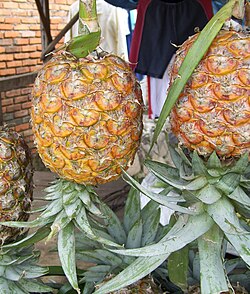
Pineapple fruit and it's stem contain Bromelain, an enzyme with anti-cough properties.
In vitro and in vivo studies demonstrate that bromelain exhibits various fibrinolytic, antiedematous, antithrombotic, and anti-inflammatory activities.[23] Bromelain accounts for many therapeutic benefits like the treatment of angina pectoris, bronchitis, sinusitis, surgical trauma, and thrombophlebitis, debridement of wounds, and enhanced absorption of drugs, particularly antibiotics.[23]
Common cough and elderberries[edit | edit source]

Elderberries (or Elder) belong to the genus w:Sambucus and may be useful for various kinds of flu.
- https://www.getholistichealth.com/78315/elderberry-eliminate-cold-flu/ lists a few studies that found it effective
- https://nccih.nih.gov/health/euroelder just states that more studies must be done to determine if it helps with flus
COVID-19 and cannabis[edit | edit source]

w:COVID-19 is a respiratory illness caused by w:Severe acute respiratory syndrome coronavirus 2.
Scientific papers
- 'Cannabinoids Block Cellular Entry of SARS-CoV-2 and the Emerging Variants' at pubs.acs.org, a 2022 in-vitro study published in w:Journal of Natural Products found that w:Cannabidiolic acid, w:Cannabigerolic acid and w:Tetrahydrocannabinolic acid are useful against COVID-19.[1st seen in 9]
- 'The Immunopathology of COVID-19 and the Cannabis Paradigm' at frontiersin.org, a February 2021 review article published in w:Frontiers in Immunology.[1st seen in 10]
- 'Fighting the storm: could novel anti-TNFα and anti-IL-6 C. sativa cultivars tame cytokine storm in COVID-19?', a January 2021 study published in w:Aging (journal)[1st seen in 11].
- 'Cannabidiol Modulates Cytokine Storm in Acute Respiratory Distress Syndrome Induced by Simulated Viral Infection Using Synthetic RNA' at liebertpub.com[1st seen in 12], a November 2020 study published in w:Cannabis and Cannabinoid Research.
- 'In search of preventive strategies: novel high-CBD Cannabis sativa extracts modulate ACE2 expression in COVID-19 gateway tissues' at aging-us.com[1st seen in 11] a November 2020 research paper. Seen earlier in 2020 as a preprint 'In Search of Preventative Strategies: Novel Anti-Inflammatory High-CBD Cannabis Sativa Extracts Modulate ACE2 Expression in COVID-19 Gateway Tissues' at PrePrints.org[1st seen in 12], in April 2020. Preprint first seen in May 2020 reporting Study: Cannabis Might Prevent COVID-19 Infections at TheFreshToast.com
- 'SARS-CoV2 induced respiratory distress: Can cannabinoids be added to anti-viral therapies to reduce lung inflammation?', a study published in April 2020.[1st seen in 13].
Reporting
- 'Medicinal cannabis mouthwash could help combat COVID-19' at calgary.ctvnews.ca Feb 2021 reporting on [1] and [2]
- 'New Study Shows Cannabis Reduces Inflammatory ‘Storms’ Caused By Covid-19' at forbes.com Jan 2021 reporting on [3]
- 'Cannabis can reduce COVID-19 complications, mitigate fibrosis - study' at jpost.com January 2021 reporting on [4]
- 'Israeli study finds efficacy in using cannabis terpenes to treat COVID-19' at jpost.com August 2020 reporting and Researchers See Promising Results Using Cannabis Terpenes To Treat COVID-19 at forbes.com August 2020 reporting on Israeli w:in vivo study Successful initial results using cannabis terpenes to treat COVID-19 at healtheuropa.eu. Obs: In Wikipedia Health Europa Quarterly redirects to w:Pan European Networks, which it complains to be a predatory publishing-for-a-fee operation.
- 'Researchers say CBD could provide vital treatment for coronavirus' at ChicagoTribune.com July 2020 reporting on [5]
- 'CBD could save lives of COVID-19 patients, AU researchers discover' at wrdw.com July 2020 reporting by w:WRDW-TV on [6]
- 'Study: Cannabis Might Prevent COVID-19 Infections' at thefreshtoast.com, May 2020 reporting on [7]
SARS and cannabis[edit | edit source]
- SARS is short for w:Severe acute respiratory syndrome and it is caused by w:Severe acute respiratory syndrome coronavirus. There was the w:2002–2004 SARS outbreak.
Scientific papers
- 'Cannabis Indica speeds up Recovery from Coronavirus' at ResearchGate.net, a March 2020 scientific study by Gershom Zajicek in the w:Hebrew University of Jerusalem
- 'Specific Plant Terpenoids and Lignoids Possess Potent Antiviral Activities against Severe Acute Respiratory Syndrome Coronavirus' at pubs.acs.org[1st seen in 12], a 2007 study on medical cannabis and w:SARS published by w:American Chemical Society publishing.
Sclerosis[edit | edit source]
“In medicine, sclerosis is the stiffening of a structure, usually caused by a replacement of the normal organ-specific tissue with connective tissue.”
Amyotrophic lateral sclerosis[edit | edit source]
Amyotrophic lateral sclerosis and cannabis[edit | edit source]
Cannabis helps with Amyotrophic lateral sclerosis (ALS) also known as Lou Gehrig's disease and motor neurone disease (MND).
Multiple sclerosis[edit | edit source]
Multiple sclerosis (MS) and cannabis[edit | edit source]
Cannabis is very good against Multiple sclerosis. Prince Charles knew of this way back in 1998[24].
Scientific articles about MS and cannabis
Compendiums of knowledge about MS and cannabis
Links about MS and cannabis
- 'Multiple Sclerosis & Cannabis: It’s All About The Terpenes', a 2017 article
- https://herb.co/news/health/marijuana-and-ms
- https://www.learngreenflower.com/articles/440/treating-multiple-sclerosis-with-cannabis
Seizures[edit | edit source]
Seizures and cannabis[edit | edit source]
Strokes[edit | edit source]
Strokes and cannabis[edit | edit source]
- 'Cannabinoids in experimental stroke: a systematic review and meta-analysis', a 2014 meta-review published in the w:Journal of Cerebral Blood Flow & Metabolism. 'Study: Cannabis May Help Reduce Brain Damage Caused By Ischemic Strokes', an MedicalJane.com article on the study
Traumatic brain injury[edit | edit source]
Traumatic brain injury and cannabis[edit | edit source]
Cannabis can help in healing from TBI
- 'Cannabis Therapeutics and the Future of Neurology: Cannabis and Traumatic Brain Injury (TBI)/Chronic Traumatic Encephalopathy (CTE)', a 2018 perspective article
Garden[edit | edit source]
Blackberries[edit | edit source]

Blackberries kill antibiotic resistant staphylococcus aureus bacteria[1]. Irish teen awarded prize for discovery.[2]
Uses
Burseraceae - The frankincense and myrrh family[edit | edit source]
“The Burseraceae are a moderate-sized family of 17-19 genera and about 540 w:species of w:flowering plants. The actual numbers differ according to the time period in which a given source is written describing this family. The Burseraceae are also known as the torchwood family,[25] the w:frankincense and w:myrrh family, or simply the incense tree family. The family includes both w:trees and w:shrubs, and is native to tropical regions of w:Africa, w:Asia. w:Australasia, and the w:Americas.”
Boswellia - Frankincense[edit | edit source]

Boswellia is a genus of trees in the order Sapindales, known for their fragrant resin. The biblical incense w:frankincense was an extract from the resin of the tree Boswellia sacra, and is now produced also from B. frereana. (Wikipedia)
“Frankincense (also known as olibanum) is an aromatic w:resin used in w:incense and w:perfumes, obtained from trees of the genus w:Boswellia in the family w:Burseraceae. The word is from w:Old French franc encens ('high-quality incense').”
In vitro studies have found boswellia sacra essential oil to induce w:apoptosis and to suppress tumor agressiveness in #Breast cancer[28]
Medical professional testifies to frankincense oil killing cancer
Links to articles about frankincense healing '
- 'Frankincense found to outperform chemo in killing Ovarian Cancer cells' 2019 popular article on GetHolisticHealth.com
Commiphora - Myrrhs[edit | edit source]
“The genus of the myrrhs, Commiphora, is the most species-rich w:genus of w:flowering plants in the w:frankincense and w:myrrh family, w:Burseraceae. The genus contains approximately 190 species of w:shrubs and w:trees, which are distributed throughout the (sub-) tropical regions of w:Africa, the western Indian Ocean islands, the w:Arabian Peninsula, w:India, and w:South America.[29][30][31] The genus is drought-tolerant and common throughout the xerophytic scrub, seasonally dry tropical forests, and w:woodlands of these regions.”
Cannabis[edit | edit source]

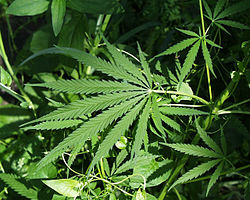
Cannabis is the oldest and most versatile medicine known to humankind.
Cannabis sativa and Cannabis indica are the main cannabis variants though most strains are mixes of these. A third cannabis line is the Cannabis ruderalis, a rugged northern cannabis that has adapted to flower even under northern long summer days.
Cannabis therapeutics[edit | edit source]

Cannabis can be applied to treat a wide assortment of illnesses. In this case it is called medical cannabis.
Some sources report cannabis useful against
- #Alzheimer's and cannabis - very strong evidence from in vivo studies
- #Autoimmune diseases and cannabis
- #Antibiotic cannabis leaves
- #Asthma and cannabis - bronchodialator
- #Autism and cannabis - many miracle stories
- #Cancers and cannabis - strong evidence of anti-cancer properties
- #Brain cancer and cannabis
- #Breast cancer and cannabis
- #Cervical cancer and cannabis
- #Colon cancer and cannabis
- #Langerhans cell sarcoma and cannabis
- #Leukemia and cannabis
- #Lymphoid leukemia and cannabis
- #Myeloid leukemia and cannabis
- #Liver cancer and cannabis
- #Lung cancer and cannabis
- #Lymphoma and cannabis
- #Oral cancer and cannabis
- #Ovarian cancer and cannabis
- #Pancreatic cancer and cannabis
- #Prostate cancer and cannabis
- #Skin cancer and cannabis
- #Melanoma and cannabis
- #Testicular cancer and cannabis
- #Thyroid cancer and cannabis
- #Crohn's disease and cannabis
- #Epilepsy and cannabis - very promising results
- #Dravet syndrome and cannabis
- #Dermatological conditions and cannabis
- #Migraines and cannabis
- #Pain and cannabis
- #Parkinson's disease and cannabis
- #Non-somatic issues with cannabis
- Scleroses
- #Respiratory diseases
- #Seizures and cannabis
- #Strokes and cannabis
- #Traumatic brain injury and cannabis
Due to the inbuilt default to always take the safe route and also to backup the back of your fellow MD colleague the Wikipedia does not yield the right infos on how useful and versatile a medication cannabis is.
Research has been held back by arcane laws even as cannabis is the oldest medicine known to man and it should be gladly appreciated and not outlawed because of big pharma interests.
Medical cannabis research and information organizations[edit | edit source]
- International Association for Cannabinoid Medicines at Cannabis-med.org is also available in German, French, Dutch, Spanish, Portuguese and Italian
- The Canadian Consortium for the Investigation of Cannabinoids is a Canadian non-profit organization
- The Center for Medicinal Cannabis Research at the University of California
- Centre for Medicinal Cannabis Research and Innovation by the govt of New South Wales
External links about cannabis as medicine[edit | edit source]
- http://www.calgarycmmc.com/ a large compendium on medical cannabis sorted alphabetically by ailment.
- http://www.cannabisconnections.tk/2018/03/700-medicinal-uses-of-cannabis-sorted.html
- http://expand-your-consciousness.com/100-scientific-studies-agree-cannabis-annihilates-cancer/ about 100 nih.gov studies linked some cases briefly described.
- https://healer.com/ - a website by Dr. Dustin Sulak D.O. - a renowned integrative medicine physician based in Maine, whose practice balances the principles of osteopathy, mind-body medicine and medical cannabis.
- Harvard Health Blog article on medical cannabis is naturally very reserved about not raising too much hopes
- 71 medical uses of cannabis compiled by LearnGreenFlower.com
- http://medicalcannabisreport.com/700-medicinal-uses-of-cannabis-sorted-by-disease/ (.pdf from 2012 downloadable from the linked page)
- https://www.rxleaf.com/clinical-research-into-cannabis-for-cancer-has-never-been-better/
Literature about cannabis as a medicine[edit | edit source]
- BPJ Volume 163, Issue 7 - 'Special Issue:Cannabinoids in Biology and Medicine, Part I.' a 2011 special issue of w:British Journal of Pharmacology.
- 'Special Issue: Themed Section 8th European Workshop on Cannabinoid Research', Volume 176, Issue 10 of the British Journal of Pharmacology.
- MARIJUANA AS MEDICINE? - The Science Beyond the Controversy (full book online), a somewhat skeptical and reserved book published in 2000 that you can read online from The National Academies Press.
- MARIHUANA: THE FORBIDDEN MEDICINE (excerpts from the book online), a 1997 book by Lester Grinspoon, M.D and James Bakalar, J.D
- 'Recent Advances in Cannabinoid Research', a 2019 open access peer-reviewed edited volume (available online and in hard copy)
Anecdotal testimonies about medical cannabis[edit | edit source]
- Anecdotal testimonies on medical cannabis at calgarymmc.com
- Anecdotal testimonies on medical cannabis at rxmarijuana.com
The endocannabinoid system[edit | edit source]
Main article in wikipedia Endocannabinoid system
Endocannabinoids are synthesized by our own bodies from Arachidonic acid, an essential polyunsaturated Omega-6 fatty acid[33].
Scientific articles about the endocannabinoid system
- 'Modulating the endocannabinoid system in human health and disease--successes and failures', a 2013 scientific article
- 'Care and Feeding of the Endocannabinoid System: A Systematic Review of Potential Clinical Interventions that Upregulate the Endocannabinoid System', a 2014 article
- 'Fatty Acid Modulation of the Endocannabinoid System and the Effect on Food Intake and Metabolism', a 2013 article
- 'The endocannabinoid system in pain and inflammation: Its relevance to rheumatic disease', a 2017 article
- 'Endocannabinoid system: Role in depression, reward and pain control' (Review), a 2016 article
- 'Care and Feeding of the Endocannabinoid System: A Systematic Review of Potential Clinical Interventions that Upregulate the Endocannabinoid System', a 2014 systematic review
- 'Fatty Acid Modulation of the Endocannabinoid System and the Effect on Food Intake and Metabolism', a 2013 study
- 'The endocannabinoid system in pain and inflammation: Its relevance to rheumatic disease', a 2017 article
- 'Potential for endocannabinoid system modulation in ocular pain and inflammation: filling the gaps in current pharmacological options', a 2018 article
- 'Dietary Omega-6/Omega-3 and Endocannabinoids: Implications for Brain Health and Diseases', a 2016 peer-reviewed chapter.
- 'Endocannabinoids and pregnancy', a 2010 literature review
- 'Endocannabinoid system, a target to improve cognitive disorders in models of Down syndrome', a 2019 animal model study found downregulating CB1 receptors beneficial for the mice.
- 'The Endocannabinoid System, Our Universal Regulator', a 2018 undergraduate research paper published in the Journal of Young Investigators
Articles about the endocannabinoid system
- 'Introduction to the Endocannabinoid System' at NORML (.org)
- 'Endocannabinoid Basics' at MedicinalGenomics.com
- 'How and Why Your Brain Makes its Own Cannabinoids', a 2016 article by Hemp Edification blog
- Endocannabinoids – Beyond the Brain is a good 2017 article on the Hemp Edification blog] adapted from Your Body Is Teeming with Weed Receptors, a 2017 article on the website the-scientist.com and Endocannabinoids in the Groove, a 2017 article on the website the-scientist.com
- http://profofpot.com/endocannabinoid-receptors/
The endocannabinoid receptors[edit | edit source]
Human body contains 2 types of endocannabinoid receptors CB1 and CB2, but cannabinoids have interactions also on some other receptors.
CB1 receptors[edit | edit source]
CB1 receptors predominantly located in the nervous system, connective tissues, gonads, glands, and organs[34].
CB2 receptors[edit | edit source]
CB2 receptors, primarily found in the immune system and also present in the spleen, liver, heart, kidneys, bones, blood vessels, lymph cells, endocrine glands, and reproductive organs[34].
Endocannabinoids[edit | edit source]
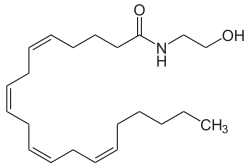
The two main endocannabinoids are Anandamide and 2-AG.
Anandamide[edit | edit source]
Anandamide was discovered in 1992 and it binds to both CB1 and CB2 receptors. The name comes from the Sanskrit word 'Ananda' meaning 'bliss' and amide from its chemistry.
It has been referred to as the endocannabinoid version of THC.
Synthesis of Anandamide: Arachidonic acid -> Phosphatidylethanolamide + N-Acyltransferase -> N-arachidonoyl phosphatidylethanolamine + Phospholipase D -> Anandamide[35]
2-AG[edit | edit source]

2-Arachidonoylglycerol aka. 2-AG was discovered in 1994-1995.
Synthesis of 2-AG: Arachidonic acid -> Phosphatidylinositol + Phospholipase Cs -> w:Diacylglycerol + Diacylglycerol lipase -> 2-AG[35]
N-Arachidonoyl dopamine[edit | edit source]
N-Arachidonoyl dopamine discovered in 2000.
2-Arachidonyl glyceryl ether[edit | edit source]
2-Arachidonyl glyceryl ether discovered in 2001.
Virodhamine[edit | edit source]
Virodhamine discovered in 2002
Lysophosphatidylinositol[edit | edit source]
Lysophosphatidylinositol is a contender to be the 6th endocannabinoid.
Phytocannabinoids[edit | edit source]

Many people may know the 2 most prevalent phytocannabinoids, THC and CBD.
Studies about phytocannabinoids
- 'Non-psychotropic plant cannabinoids: new therapeutic opportunities from an ancient herb.', a 2009 article
- 'The United Chemicals of Cannabis: Beneficial Effects of Cannabis Phytochemicals on the Brain and Cognition', a 2018 open-access peer-reviewed chapter in Recent Advances in Cannabinoid Research
Links about phytocannabinoids
List of known phytocannabinoids from Wikipedia:
- THC (Tetrahydrocannabinol)
- THCA (Tetrahydrocannbinolic acid)
- CBD (Cannabidiol)
- CBDA (Cannabidiolic Acid)
- CBN (Cannabinol)
- CBG (Cannabigerol)
- CBC (Cannabichromene)
- CBL (Cannabicyclol)
- CBV (Cannabivarin)
- THCV (Tetrahydrocannabivarin)
- CBDV (Cannabidivarin)
- CBCV (Cannabichromevarin)
- CBGV (Cannabigerovarin)
- CBGM (Cannabigerol Monomethyl Ether)
- CBE (Cannabielsoin)
- CBT (Cannabicitran)
THC[edit | edit source]

Tetrahydrocannabinol was found in 1964[37] and it is the main psychoactive compound that brings the 'high' most recreational users are chasing.
THCA[edit | edit source]
Tetrahydrocannabinolic acid THCA is the what cannabis plants produce to fend off insects from harming it. In pure form THCA is a clear translucent crystalline of white color.
THC is produced from the raw THCA by a process called decarboxylation. Basically means to heat the stuff over certain temperature.
THCA found in raw marijuana apparently has some health enhancing properties. The issue is being researched.
- https://herb.co/news/health/raw-weed-benefits/
- https://herb.co/learn/eat-raw-weed-marijuana/
- https://thefreshtoast.com/cannabis/marijuanas-thc-a-as-an-anti-inflammatory-and-neuro-protectant/
CBD[edit | edit source]

Cannabidiol was isolated and identified from Cannabis sativa in 1940[37]. CBD is not psychoactive and it has the most medical applications of all phytocannabinoids.
“Cannabidiol has little affinity for CB1 and CB2 receptors but acts as an indirect antagonist of cannabinoid agonists.[38]”
- Hightimes in detail piece on CBD
- Leafly lists strains high in CBD
- Piece on CBD as anti-pain agent (contains ads)
- 'Cannabidiol attenuates aggressive behavior induced by social isolation in mice: Involvement of 5-HT1A and CB1 receptors', a 2019 study published in the w:Progress in Neuro-Psychopharmacology & Biological Psychiatry. Cannabidiol effects were mediated by CB1 and 5-HT1A receptors.
- WHO preliminary report on CBD
CBDA[edit | edit source]
Cannabidiolic Acid is the raw form. Decarboxylating CBDA yields CBD.
CBN[edit | edit source]
Cannabinol is a sleeping aid and has also other therapeutic qualities.
- https://www.leafly.com/news/science-tech/what-is-cbn-and-what-are-the-benefits-of-this-cannabinoid
- https://www.massroots.com/learn/cannabinol-cbn-cannabinoid/
- https://www.medicaljane.com/2013/08/19/cannabinol-cbn-will-put-you-to-bed/
CBG[edit | edit source]
“Cannabigerol has been shown to promote apoptosis in cancer cells and inhibit tumor growth in mice. It acts as an α2-adrenergic receptor agonist, 5-HT1A receptor antagonist, and CB1 receptor antagonist.[39] It also binds to the CB2 receptor.[39]”
Links about CBG
CBC[edit | edit source]
CBL[edit | edit source]
CBV[edit | edit source]
THCV[edit | edit source]
Tetrahydrocannabivarin can be used to inhibit appetite.
Links about THCV
CBDV[edit | edit source]
CBCV[edit | edit source]
Cannabichromevarin
CBGV[edit | edit source]
Cannabigerovarin
CBGM[edit | edit source]
Cannabigerol Monomethyl Ether
CBE[edit | edit source]
Cannabielsoin
CBT[edit | edit source]
Cannabicitran
Making cannabinoids with yeasts[edit | edit source]
Scientists have figured out how to splice the DNA of yeasts, so that they produce cannabinoids.[40]
Cannflavins[edit | edit source]
Cannaflavins A and B are very potent anti-inflammatory agents and thus help lessen the pain sensation originating from inflammation.
Scientific articles about cannflavins
- 'Biosynthesis of cannflavins A and B from Cannabis sativa L.', published in 2019 in Phytochemistry found results that imply the following reaction sequence for cannflavins A and B biosynthesis: luteolin ► chrysoeriol ► cannflavin A and cannflavin B.
Links about cannflavins
Terpenes in cannabis[edit | edit source]
Terpenes are a large and diverse class of organic compounds, produced by a variety of plants, particularly conifers, and by some w:insects.[41]
Links about terpenes found in cannabis
- 'Multiple Sclerosis & Cannabis: It’s All About The Terpenes', a 2017 article
- '15 terpenes in cannabis explained', a 2018 article by CannaCon.org
- 'Terpenes' by Fundación CANNA, a non-profit organization dedicated to scientific studies and cannabis testing
- 'Why terpenes are becoming more important than THC', a 2019 articleon the Spokesman.com
Synthetic cannabinoids[edit | edit source]
Synthetic cannabinoids are a class of molecules that bind to cannabinoid receptors in the body — the same receptors to which THC and CBD attach – which are cannabinoids in cannabis plants. (Wikipedia)
Word of caution: Many synthetic cannabinoids are dangerous and should not be administered by others than medical professionals.
- List of synthetic cannabinoids on Wikipedia
- Structural scheduling of synthetic cannabinoids on Wikipedia
Links about synthetic cannabinoids
- CalgaryMMC.com lists ACEA so this isn't one is probably not one of the harmful ones
Arachidonyl-2'-chloroethylamide (ACEA) is a synthetic agonist of the CB1 receptor. (Wikipedia)
Other plants that contain compounds that are active in cannabinoid receptors[edit | edit source]
- Echinacea contains N-alkylamides, that function via cannabimemetics to provide immune-boosting and is also used to relieve anxiety, fatigue, migraines and arthritis.[42]
- Black pepper contains high levels of the terpene called β-caryophyllene (BCP). BCP functions as a cannabinoid, and has a binding affinity with the CB2 receptor.[42]
- Flax (linen) seeds produce cannabinoid-like compounds very similar to CBD.[42]
- Cacao contains lots of magnesium, but also "happy-brain" chemicals like theobromine, phenethylamine, tryptophan, and anandamide. Cacao affects the endocannabinoid system by deactivating the enzyme called FAAH. This enzyme breaks down the endocannabinoid known as anandamide.[42]
- Black truffles contain anandamide.[42]
- Helichrysum umbraculigerum contains cannabigerol (CBG).[42]
- Rhododendron anthopogonoides (Chinese Labrador) contains anthopogocyclolic acid and anthopogochromenic acid and five related compounds known as synthetic analogues of cannabinoids: cannabichromene (CBC) type, cannabicyclol (CBL) type and cannabicitran (CBT) type, have been isolated together with geranyl orsellinic acid. [42]
- Liverwort contains Perrottetinene, a cannabinoid similar to THC.[43][42]
- https://herb.co/learn/non-marijuana-plants-contain-cannabinoids/
- https://livelovefruit.com/8-non-marijuana-plants-contain-cannabinoids/
- https://www.marijuana.com/news/2017/05/9-plants-that-contain-therapeutic-cannabinoids/
Administering cannabis[edit | edit source]
There are various other ways to administer cannabis methods besides smoking it:
Vaping cannabis[edit | edit source]
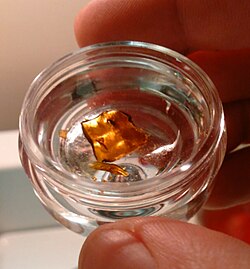
- Vaping (short for vaporizing), a method where the plant material is heated hot enough for the cannabinoids to become gaseous but cold enough that the plant matter does not combust and thus avoiding the carcinogens that come from burning the plant matter. Vaping is also the preferred method to consume concentrates.
Links
Oral cannabis[edit | edit source]
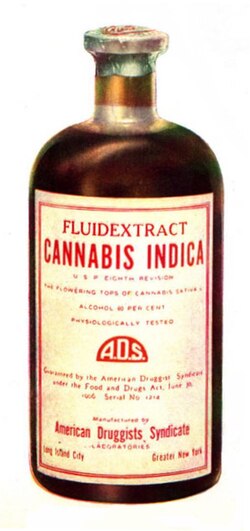
- Edibles, tinctures and cannabis oil may be administered orally. Cannabinoids are soluble to alcohol and to fat and cannabis can be infused into many forms of edibles, but the problem is with efficiency as your stomach acids will destroy a lot of the cannabinoids.
Links
- Harvard Health Blog on edibles
- Do Edibles Give You A Different High Than Smoking? article at tonic.vice.com
- Herb.co guide to making cannabis oil (word of caution: the procedure is dangerous as there are risks of explosion if done wrong, so don't be toasted outta it if and when you decide to make cannabis oil)
Rectal cannabis[edit | edit source]
- Rectal - some doctors recommend taking cannabis rectally as this is method of administering allows you to take very large doses efficiently.[44]
Links
- https://hightimes.com/health/science/doctors-orders-put-marijuana-in-your-butt-dont-smoke-it/
- https://www.huffingtonpost.ca/2017/03/05/rectal-marijuana_n_15178784.html
- https://inhalemd.com/massachusetts-medical-cannabis-guide/how-to-make-cannabis-suppositories-at-home/
- https://www.leafly.com/news/health/dont-laugh-rectal-suppositories-future-medicinal-cannabis
- https://www.medicaldaily.com/rectal-medical-marijuana-effective-safer-smoking-weed-suppository-wont-be-413077
- https://www.rxleaf.com/tush-kush-what-you-need-to-know-about-suppositories
Topical cannabis[edit | edit source]
- Topicals - for some skin affecting conditions this is a good way to administer the medicine. Many skin condition sufferers praise the combination of cannabis and coconut oil to make a topical to apply to the affected skin.
[edit | edit source]
Right under the belly button there is a gland called Pechoti, which some say is a very good way to administer medical cannabis. Naval administration of medicine is a method used by the ancient Ayurvedic medicine.
Links
- https://canna-lance.com/2018/08/27/did-you-know-you-could-consume-cannabis-like-this/
- https://www.portlandmercury.com/blogtown/2019/07/17/26809203/a-new-way-to-consume-cannabis-through-your-belly-button
Celery[edit | edit source]

Dandelion[edit | edit source]
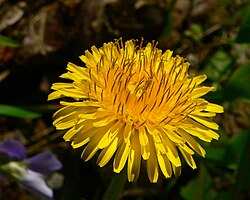
Dandelion root concentrates found effective against several cancers.
The Dandelion Root Project at University of Windsor, Ontario has studied dandelion root since 2009 and they state on on their website:
“Since the commencement of this project, we have been able to successfully assess the effect of a simple water extract of dandelion root in various human cancer cell types, in the lab and we have observed its effectiveness against human T cell leukemia, chronic myelomonocytic leukemia, pancreatic and colon cancers, with no toxicity to non-cancer cells. Furthermore, these efficacy studies have been confirmed in animal models (mice) that have been transplanted with human colon cancer cells.[19]”
- #T cell leukemia and dandelion root
- #Chronic myelomonocytic leukemia and dandelion root
- #Pancreatic cancer and dandelion root
- #Colon cancer and dandelion root
Scientific studies about dandelion root and cancers
- #Prostate cancer and dandelion root 'Evaluation of aqueous extracts of Taraxacum officinale on growth and invasion of breast and prostate cancer cells', a 2008 study
- #Melanoma and dandelion root 'The efficacy of dandelion root extract in inducing apoptosis in drug-resistant human melanoma cells.', a 2010 study
- #Pancreatic cancer and dandelion root'Selective induction of apoptosis and autophagy through treatment with dandelion root extract in human pancreatic cancer cells.', a 2010 study
- #Breast cancer and dandelion
Summary of known dandelion health benefits
Links about dandelion and cancers
- Dandelion root ‘found to kill’ chemo-resistant melanoma and leukemia a 2019 article at GetHolisticHealth.com chemo-resistant melanoma and leukemia.[45]
Elderberries[edit | edit source]

Elderberries (or Elder) belong to the genus w:Sambucus and may be useful for various kinds of flu.
Uses
Ginger[edit | edit source]

Ginger (Zingiber officinale) is a flowering plant whose rhizome, ginger root or ginger, is widely used as a spice and a folk medicine.[46]
Ginger is in the family Zingiberaceae, which also includes turmeric (Curcuma longa), cardamom (Elettaria cardamomum), and galangal.[46]
“Gingerol has been investigated w:in vitro for its effect on cancerous tumors of the bowel,[14][15] breast tissue,[16] ovaries,[17] and pancreas,[18] with positive results.”
Scientific articles about ginger and health
- 'Ginger and its active constituents as therapeutic agents: Recent perspectives with molecular evidences' at ncbi.nlm.nih.gov, a 2020 literature review on the health and anti-disease effects of ginger published in International Journal of Health Sciences by w:Qassim University, Saudi Arabia
- '6-gingerol content of ginger (Zingiber officinale Roscoe) by different drying methods', a 2018 study presented at the 2018 International Congress on Botanical research in Tropical Asia
- 'Comparison of different drying methods on Chinese ginger (Zingiberofficinale Roscoe): Changes in volatiles, chemical profile, antioxidant properties, and microstructure', a 2015 study
Links and reporting about ginger's health effects
Possible medical applications of ginger
- #Alzheimer's and ginger
- #Rheumatoid arthritis and ginger
- #Breast cancer and ginger
- #Colon cancer and ginger
- #Leukemia and ginger
- #Lung cancer and ginger
- #Ovarian cancer and ginger
- #Pancreatic cancer and ginger
Chemistry of ginger[edit | edit source]
The characteristic fragrance and flavor of ginger result from volatile oils that compose 1-3% of the weight of fresh ginger, primarily consisting of zingerone, ls, and gingerols with [6]-gingerol (1-[4'-hydroxy-3'-methoxyphenyl]-5-hydroxy-3-decanone) as the major pungent compound.[47] Zingerone is produced from gingerols during drying, having lower pungency and a spicy-sweet aroma.[47] Shagoals are more pungent and have higher antioxidant activity but not found in raw ginger, but is formed from gingerols during heating, storage or via acidity.[47][48]
Fresh ginger also contains an enzyme zingibain which is a cysteine protease and has similar properties to rennet.[48]
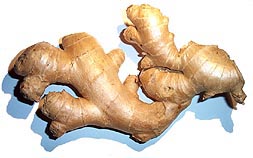
11 health benefits of ginger at healthline.com (with sources)
- Ginger contains w:Gingerol, a substance with powerful anti-inflammatory and antioxidant properties.[1st seen in 4]
- Ginger can treat many forms of nausea, especially morning sickness and chemo-induced nausea[1st seen in 4]
- Ginger may reduce muscle pain and soreness [1st seen in 4]
- Ginger can help with w:osteoarthritis [1st seen in 4]
- Ginger may lower blood sugars [1st seen in 4]
- Ginger can help treat chronic indigestion [1st seen in 4]
- Ginger powder may significantly reduce menstrual pain [1st seen in 4]
- Ginger may lower cholesterol levels [1st seen in 4]
- Ginger contains gingerol, which may help to prevent cancers [1st seen in 4]
- Ginger may improve brain functioning and protect against Alzheimer's disease [1st seen in 4]
- Gingerol can help lower risk of infections [1st seen in 4]
Oregano[edit | edit source]

w:Oregano (Origanum vulgare) contains w:carvacrol, w:thymol, w:limonene, w:pinene, w:ocimene and w:caryophyllene.
Oregano oil can contain very high percentages of w:carvacrol, whereas thyme is a great source of thymol.
Studies on carvacrol and / or thymol
- 'Antitumor Effects of Carvacrol and Thymol: A Systematic Review' at frontiersin.org, a systematic review article published in w:Frontiers in Pharmacology on 2021-07-07
- 'Apoptotic effects of thymol, a novel monoterpene phenol, on different types of cancer' at pubmed.ncbi.nlm.nih.gov[1st seen in 14], a 2020 study published in Bratislavske Lekarske Listy found thymol to have apoptotic and antiproliferative properties in lung, breast, and prostate cancer cell lines.
- 'Carvacrol suppresses proliferation and invasion in human oral squamous cell carcinoma' at ncbi.nlm.nih.gov[1st seen in 14], a 2016 in vitro study on carvacrol w:oral squamous cell carcinoma published in w:OncoTargets and Therapy.
- 'Effects of Carvacrol on a Human Non-Small Cell Lung Cancer (NSCLC) Cell Line, A549' at pubmed.ncbi.nlm.nih.gov[1st seen in 14], a 2003 in vitro study of w:Non-small-cell lung cancer and carvacrol.
Links to reporting about carvacrol / oregano oil
Papaya[edit | edit source]
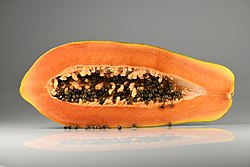
- https://livelovefruit.com/eat-papaya-seeds-detoxify-liver-kidneys-heal-digestive-tract/ (SOURCEME)
- Papaya Seed Represents a Rich Source of Biologically Active Isothiocyanate at pubs.acs.org[1st seen in 15], a 2007 study published in w:Journal of Agricultural and Food Chemistry. Keywords: w:Papaya; w:isothiocyanate; w:glucosinolate; w:apoptosis; antioxidant; w:HL-60 (human w:leukemia w:cell line)
Parsley[edit | edit source]

"w:Parsley contains the compound w:apigenin, which increases levels of two w:enzymes called w:glutathione reductase and w:superoxide dismutase. These enzymes have been found to shrink certain breast cancer tumors. " (livelovefruit.com)
- https://livelovefruit.com/20-incredible-health-benefits-of-drinking-parsley-juice/ (SOURCEME)
- Breast Cancer Effectively Treated with Chemical Found in Celery, Parsley by MU Researchers at munewsarchives.missouri.edu (SOURCEME)
Pineapple[edit | edit source]

Pineapple fruit and it's stem contain Bromelain, an enzyme with anti-cough properties.
In vitro and in vivo studies demonstrate that bromelain exhibits various fibrinolytic, antiedematous, antithrombotic, and anti-inflammatory activities.[23] Bromelain accounts for many therapeutic benefits like the treatment of angina pectoris, bronchitis, sinusitis, surgical trauma, and thrombophlebitis, debridement of wounds, and enhanced absorption of drugs, particularly antibiotics.[23]
Uses
Polyphenols[edit | edit source]
“Polyphenols also known as polyhydroxyphenols) are a structural class of mainly natural, but also synthetic or semisynthetic, organic chemicals.”
More than 8,000 types of polyphenols have been identified. They can be further categorized into 4 main groups[49]
- Flavonoids (or bioflavonoids) (from the Latin word flavus, meaning yellow, their color in nature) are a class of plant and fungus secondary metabolites. (Wikipedia). These account for around 60% of all polyphenols. Examples include quercetin, kaempferol, catechins, and anthocyanins, which are found in foods like apples, onions, dark chocolate, and red cabbage.[49]
- Phenolic acids or phenolcarboxylic acids are types of aromatic acid compound (Wikipedia). This group accounts for around 30% of all polyphenols. Examples include stilbenes and lignans, which are mostly found in fruits, vegetables, whole grains, and seeds.[49]
- Polyphenolic amides. This category includes capsaicinoids in chili peppers and avenanthramides in oats.[49]
- Other polyphenols. This group includes resveratrol in red wine, ellagic acid in berries, curcumin in turmeric, and lignans in flax seeds, sesame seeds, and whole grains.[49]
Scientific articles
- Compendium of scientific studies about polyphenols at ScienceDirect.com
- 'The Role of Polyphenols in Human Health and Food Systems: A Mini-Review' , a mini-review article published in w:Frontiers Media's Frontiers in Nutrition in 2018-11
In Wikipedia
Links
Spirulina[edit | edit source]
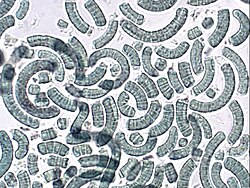
Spirulina is a biomass of a (blue-green algae) that can be consumed by humans and other animals. The two species are Arthrospira platensis and A. maxima. ( Wikipedia )
Spirulina is extremely high in protein, contains an almost perfect balance of Omega-3 to Omega-6, and is rich in the following minerals: iron, copper, calcium, magnesium, potassium, phosphorous, selenium and zinc. It also contains high levels of vitamin A, C, E, K, B6, folate, niacin, pantothenic acid, riboflavin and thiamin. [50]
Spirulina has been found to help against [50]
- HIV/AIDS
- Beneficial for Type 2 Diabetes by regulating blood sugar levels and helping with w:blood lipids composition
- Candida
- Cancers because of its high C-phycocyanin, a powerful antioxidant and anti-inflammatory substance and anti-cancer properties
- Binding to w:heavy metals and therefore aiding in their removal
- Heart disease
- Allergies
Stevia[edit | edit source]

Stevia is a sweetener and sugar substitute extracted from the leaves of the plant species Stevia rebaudiana, native to Brazil and Paraguay.
Medical uses of stevia
Tea[edit | edit source]
Turmeric[edit | edit source]

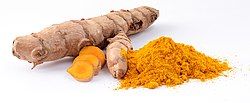
Turmeric contains curcumin, a curcuminoid.
Studies regarding turmeric
- 'Curcumin ingestion and exercise training improve vascular endothelial function in postmenopausal women.', a 2012 study. + LiveLoveFruit.com reporting on the study
- 'Attenuation of Morphine Withdrawal Syndrome by Various Dosages of Curcumin in Comparison with Clonidine in Mouse: Possible Mechanism' , a 2015 study
Possible medical applications of turmeric
Links and reporting about turmeric
See also: Cancers and cannabis (intra-article link)
Information sources on natural therapeutics[edit | edit source]
Scientific[edit | edit source]
- Dr. Duke's Phytochemical and Ethnobotanical Databases at phytochem.nal.usda.gov[1st seen in 16] - "Dr. Duke's Phytochemical and Ethnobotanical databases facilitate in-depth plant, chemical, bioactivity, and ethnobotany searches using scientific or common names. Search results can be downloaded in PDF or spreadsheet form. Of interest to pharmaceutical, nutritional, and biomedical research, as well alternative therapies and herbal products. "
- 'Potential Herb–Drug Interactions in the Management of Age-Related Cognitive Dysfunction' at ncbi.nlm.nih.gov, a 2021 literature review on natural therapeutics published in Pharmaceutics (journal). The researchers unfortunately excluded cannabis from the study.
Other[edit | edit source]
- https://www.anniesremedy.com/
- Get Holistic Health publishes lots of articles on natural therapeutics, but also other topics.
- GreenMedinfo - The Science of Natural Healing
- HealthLine.com contains a myriad of information about different medical conditions and in addition to having info on conditions and natural therapeutics it also covers main stream medications
- Hemp Edification blog
- https://herbalremediesbook.com/[contacted 2]
- https://livelovefruit.com/ is excellent website on health tips / natural therapeutics by Carly Fraser, a professional in the field.
- https://naturalmedicines.therapeuticresearch.com/ by https://trchealthcare.com/ is a vast database, but it is mostly available only to for-a-fee subscribers. Subscriptions start at $177 (as of 2020-07-30)
- United Patients Group focuses on the healing potential of cannabis, but also carries stories on other natural therapeutics. United Patients Group also maintains and updates a directory of medical cannabis health care professionals and clinics.
In Wikimedia Foundation wikis[edit | edit source]
Sources of links[edit | edit source]
TrueActivist.com 100 studies on cannabis against cancers 2017[edit | edit source]
Source TrueActivist.com 2017 popular article 'There Are Now 100 Scientific Studies Proving Cannabis Cures Cancer', licensed under CC-BY 4.0, found via Suomen Kannabisyhdistys original post by Eva Surnameredacted (you know who you are) in Suomen kannabisfoorumi facebook page on 2019-11-10. Please keep the <ref group="1st seen in" name="trueactivist.com 2017"> attached to the entries.[1st seen in 6].
Jennifer Huse's lists[edit | edit source]
- Jennifer Huse at independent.academia.edu[contacted 3] and her 2020 publication Cannabis Research : 1,300+ studies demonstrating beneficial effects at academia.edu[1st seen in 17] together with Hank Pellissier
This is probably the same Jennifer Huse as 'How I Kicked Cancer with Cannabis – Article by Jennifer A. Huse' at transhumanist-party.org that compiled the 1008 studies. Safe to say that credit for compiling these goes to Jennifer A. Huse.
References[edit | edit source]
- ↑ 1.0 1.1 https://www.ncbi.nlm.nih.gov/pubmed/28270804
- ↑ 2.0 2.1 https://www.hygiene-in-practice.com/publication/student-discovers-blackberry-antibiotic-for-multi-resistant-pathogens/
- ↑ https://www.researchgate.net/publication/322697165_In_vitro_antibacterial_activity_of_Cannabis_sativa_leaf_extracts_to_some_selective_pathogenic_bacterial_strains
- ↑ Bruce, Debra Fulghum; PhD. "Rheumatic Diseases: Types, Causes, and Diagnosis". WebMD. Retrieved 2022-05-10.
- ↑ Falkenburg, W.J.J. (November 2015). "IgG Subclass Specificity Discriminates Restricted IgM Rheumatoid Factor Responses From More Mature Anti–Citrullinated Protein Antibody–Associated or Isotype-Switched IgA Responses". Arthritis & Rheumatology. 67 (12): 3124–3134. doi:10.1002/art.39299. PMID 26246004.
- ↑ Edkins A, Cushley W (2012). "The Jekyll and Hyde nature of antibodies". Biological Sciences Review. 25 (2): 4.
- ↑ Funk, Janet L.; Frye, Jennifer B.; Oyarzo, Janice N.; Timmermann, Barbara N. (2009). "Comparative Effects of Two Gingerol-Containing Zingiber officinale Extracts on Experimental Rheumatoid Arthritis". Journal of Natural Products. 72 (3): 403–7. doi:10.1021/np8006183. PMC 2837120. PMID 19216559.
- ↑ https://www.sciencedirect.com/science/article/pii/S0304383508002310
- ↑ 9.0 9.1 9.2 9.3 https://herb.co/news/health/cannabis-kills-cancer/
- ↑ https://herb.co/news/health/world-first-cannabis-chemotherapy/
- ↑ https://www.medicinalcannabis.nsw.gov.au/clinical-trials/chemotherapy-trial
- ↑ https://www.medicaldaily.com/marijuana-just-might-help-cure-one-deadliest-forms-brain-cancer-410947
- ↑ https://web.archive.org/web/20181229083812/https://www.wphealth.cc/2018/10/11/fda-approves-cannabis-for-brain-cancer-treatment/ last working archive for that webpage
- ↑ 14.0 14.1 14.2 14.3 14.4 "Ginger 'could halt bowel cancer'". w:BBC News. October 29, 2003.
- ↑ 15.0 15.1 15.2 15.3 15.4 Jeong, C.-H.; Bode, A. M.; Pugliese, A.; Cho, Y.-Y.; Kim, H.-G.; Shim, J.-H.; Jeon, Y.-J.; Li, H.; et al. (2009). "[6]-Gingerol Suppresses Colon Cancer Growth by Targeting Leukotriene A4 Hydrolase". Cancer Research. 69 (13): 5584–91. doi:10.1158/0008-5472.CAN-09-0491. PMID 19531649.
- ↑ 16.0 16.1 16.2 16.3 16.4 Lee, H; Seo, E; Kang, N; Kim, W (2008). "[6]-Gingerol inhibits metastasis of MDA-MB-231 human breast cancer cells". The Journal of Nutritional Biochemistry. 19 (5): 313–9. doi:10.1016/j.jnutbio.2007.05.008. PMID 17683926.
- ↑ 17.0 17.1 17.2 17.3 17.4 Rhode, Jennifer; Fogoros, Sarah; Zick, Suzanna; Wahl, Heather; Griffith, Kent A; Huang, Jennifer; Liu, J Rebecca (2007). "Ginger inhibits cell growth and modulates angiogenic factors in ovarian cancer cells". BMC Complementary and Alternative Medicine. 7: 44. doi:10.1186/1472-6882-7-44. PMC 2241638. PMID 18096028.
- ↑ 18.0 18.1 18.2 18.3 18.4 Park, Yon Jung; Wen, Jing; Bang, Seungmin; Park, Seung Woo; Song, Si Young (2006). "[6]-Gingerol Induces Cell Cycle Arrest and Cell Death of Mutant p53-expressing Pancreatic Cancer Cells". Yonsei Medical Journal. 47 (5): 688–97. doi:10.3349/ymj.2006.47.5.688. PMC 2687755. PMID 17066513.
- ↑ 19.0 19.1 19.2 19.3 19.4 https://www.uwindsor.ca/dandelionrootproject/
- ↑ Semwal, RB; Semwal, DK; Combrinck, S; Viljoen, AM. "Gingerols and shogaols: Important nutraceutical principles from ginger". Phytochemistry. 117: 554–68. doi:10.1016/j.phytochem.2015.07.012. PMID 26228533.
- ↑ Semwal, RB; Semwal, DK; Combrinck, S; Viljoen, AM. "Gingerols and shogaols: Important nutraceutical principles from ginger". Phytochemistry. 117: 554–68. doi:10.1016/j.phytochem.2015.07.012. PMID 26228533.
- ↑ Effectiveness of Stevia Rebaudiana Whole Leaf Extract Against the Various Morphological Forms of Borrelia Burgdorferi in Vitro at pubmed.ncbi.nlm.nih.gov, a November 2015 in-vitro study published in European Journal of Microbiology and Immunology.
- ↑ 23.0 23.1 23.2 23.3 https://www.ncbi.nlm.nih.gov/pmc/articles/PMC3529416/
- ↑ https://www.theguardian.com/uk/1998/dec/24/monarchy.ameliagentleman
- ↑ Dimmitt, Mark A. "Burseraceae (torchwood family)". Arizona-Sonora Desert Museum. Arizona-Sonora Desert Museum. Retrieved 13 March 2016.
- ↑ quote fetched 2022-10-17 from version https://en.wikipedia.org/w/index.php?title=Burseraceae&oldid=1068780504
- ↑ quote sourced on 2022-10-17 from https://en.wikipedia.org/w/index.php?title=Frankincense&oldid=1112800088
- ↑ https://bmccomplementalternmed.biomedcentral.com/articles/10.1186/1472-6882-11-129 'Boswellia sacra essential oil induces tumor cell-specific apoptosis and suppresses tumor aggressiveness in cultured human breast cancer cells'], a 2011 in vitro study
- ↑ Daly et al. 2011. Burseraceae. Families and genera of vascular plants. 10:76–104.
- ↑ Weeks, A. and Simpson, B.B. 2007. Molecular phylogenetic analysis of Commiphora (Burseraceae) yields insight on the evolution and historical biogeography of an “impossible” genus. Molecular Phylogenetics and Evolution. 42:62–79.
- ↑ "Commiphora Jacq. | Plants of the World Online | Kew Science". Plants of the World Online. Retrieved 2022-05-05.
- ↑ quote fetched 2022-10-17 from version https://en.wikipedia.org/w/index.php?title=Commiphora&oldid=1086242825
- ↑ https://wakeup-world.com/2014/09/08/the-endocannabinoid-system-and-how-thc-cures-cancer/
- ↑ 34.0 34.1 https://patients4medicalmarijuana.wordpress.com/2017/07/06/how-and-why-your-brain-makes-its-own-cannabinoids/
- ↑ 35.0 35.1 https://www.ncbi.nlm.nih.gov/pmc/articles/PMC5685274/
- ↑ https://link.springer.com/chapter/10.1007/978-1-59259-947-9_2
- ↑ 37.0 37.1 https://en.wikipedia.org/wiki/Tetrahydrocannabinol
- ↑ Mechoulam, Raphael; Peters, Maximilian; Murillo-Rodriguez, Eric; Hanuš, Lumír O. (2007). "Cannabidiol – Recent Advances". Chemistry & Biodiversity. 4 (8): 1678–92. doi:10.1002/cbdv.200790147. PMID 17712814.
- ↑ 39.0 39.1 Cascio, MG; Gauson, LA; Stevenson, LA; Ross, RA; Pertwee, RG (2010). "Evidence that the plant cannabinoid cannabigerol is a highly potent α2-adrenoceptor agonist and moderately potent 5HT1A receptor antagonist". British Journal of Pharmacology. 159 (1): 129–41. doi:10.1111/j.1476-5381.2009.00515.x. PMC 2823359. PMID 20002104.
- ↑ http://globalhealthtimes.com/2019/03/06/scientists-are-making-thc-and-cbd-in-a-lab-without-growing/
- ↑ Eberhard Breitmaier (2006). Terpenes: Flavors, Fragrances, Pharmaca, Pheromones. Wiley-VCH. doi:10.1002/9783527609949. ISBN 9783527609949.
- ↑ 42.0 42.1 42.2 42.3 42.4 42.5 42.6 42.7 https://livelovefruit.com/8-non-marijuana-plants-contain-cannabinoids/
- ↑ https://www.newsweek.com/medical-marijuana-moss-plant-acts-thc-cannabis-1184661
- ↑ https://hightimes.com/health/science/doctors-orders-put-marijuana-in-your-butt-dont-smoke-it/
- ↑ https://www.getholistichealth.com/79015/dandelion-root-kill-melanoma-leukemia/
- ↑ 46.0 46.1 https://en.wikipedia.org/w/index.php?title=Ginger&oldid=925126238
- ↑ 47.0 47.1 47.2 An K, Zhao D, Wang Z, et al. (2016). "Comparison of different drying methods on Chinese ginger (Zingiber officinale Roscoe): Changes in volatiles, chemical profile, antioxidant properties, and microstructure". Food Chem. 197 (Part B): 1292–300. doi:10.1016/j.foodchem.2015.11.033. PMID 26675871. Cite uses deprecated parameter
|displayauthors=(help) - ↑ 48.0 48.1 https://en.wikipedia.org/wiki/Ginger#Chemistry
- ↑ 49.0 49.1 49.2 49.3 49.4 https://www.healthline.com/nutrition/polyphenols
- ↑ 50.0 50.1 https://livelovefruit.com/top-spirulina-benefits/
Contacted[edit | edit source]
- ↑ Sent the current owner of the company https://www.unityrd.com/general-media-inquiries that purveyed the product to the kid
- ↑ sent a note to their webmaster about having a server error 523. said will buy book any day now
- ↑ Sent Jennifer Huse a message about some problems with her lists and an offer to help if I can.
1st seen in[edit | edit source]
- ↑ http://www.cannabis-med.org/english/studies.htm
- ↑ 2.0 2.1 2.2 2.3 First seen in Jennifer A. Huse medical cannabis research list (incl. possibly non-peer reviewed) by Jennifer Huse at independent.academia.edu This is probably the same Jennifer A. Huse 'How I Kicked Cancer with Cannabis – Article by Jennifer A. Huse' at transhumanist-party.org Original list was at brighterbrains.institute/cannabis-research-compiled-by-jennifer-huse "Cannabis research compiled by Jennifer Huse" at brighterbrains.institute and was accessed / poorly ripped on 2019-12-02. As of 2020-07-16 the above URL redirects to a 404 on at the address humanistglobal.charity/cannabis-research-compiled-by-jennifer-huse. Credit for compiling these goes to Jennifer Huse.
- ↑ https://www.ingentaconnect.com/content/ben/car/2012/00000009/00000004/art00012
- ↑ 4.00 4.01 4.02 4.03 4.04 4.05 4.06 4.07 4.08 4.09 4.10 4.11 4.12 4.13 4.14 https://www.healthline.com/nutrition/11-proven-benefits-of-ginger
- ↑ 'Cannabis Could Be Reversing Damage to Arthritic Joints' archived version at web.archive.org originally at ehealthmagz.com
- ↑ 6.00 6.01 6.02 6.03 6.04 6.05 6.06 6.07 6.08 6.09 6.10 6.11 6.12 6.13 6.14 6.15 6.16 6.17 6.18 6.19 6.20 6.21 6.22 6.23 6.24 6.25 6.26 6.27 6.28 https://www.trueactivist.com/there-are-now-100-scientific-studies-proving-cannabis-cures-cancer/ CC-BY-4.0 https://www.trueactivist.com/there-are-now-100-scientific-studies-proving-cannabis-cures-cancer/ Source found via Suomen Kannabisyhdistys original post by Eva (you know who you are) in Suomen kannabisfoorumi facebook page on. Found on 2019-11-10
- ↑ https://jagwire.augusta.edu/cbd-reduces-glioblastomas-size-supportive-environment-in-experimental-model/
- ↑ https://www.facebook.com/RxleafMD/posts/1216835445411745
- ↑ https://www.hs.fi/ulkomaat/art-2000008536878.html
- ↑ Searching on search engine for fulltext or even an abstract of https://www.healtheuropa.eu/successful-initial-results-using-cannabis-terpenes-to-treat-covid-19/101986/
- ↑ 11.0 11.1 https://calgary.ctvnews.ca/medicinal-cannabis-mouthwash-could-help-combat-covid-19-1.5294988
- ↑ 12.0 12.1 12.2 https://thefreshtoast.com/news/study-cannabis-might-prevent-covid-19-infections/
- ↑ https://www.chicagotribune.com/marijuana/sns-tft-cbd-coronavirus-treatment-research-20200709-4gp2a2w76fah7p277n3ss42yby-story.html
- ↑ 14.0 14.1 14.2 14.3 '15 Health Benefits of Oregano Oil and How to Use It' at livelovefruit.com
- ↑ https://livelovefruit.com/eat-papaya-seeds-detoxify-liver-kidneys-heal-digestive-tract/
- ↑ https://en.wikipedia.org/wiki/Commiphora_myrrha 2022-10-15
- ↑ https://www.academia.edu/42868777/Cannabis_Research_1_300_studies_that_demonstrate_beneficial_effects
- ↑ First seen in Jennifer A. Huse medical cannabis research list strictly science (Only peer-reviewed science) by Jennifer Huse at independent.academia.edu This is probably the same Jennifer A. Huse 'How I Kicked Cancer with Cannabis – Article by Jennifer A. Huse' at transhumanist-party.org Original list was at brighterbrains.institute/cannabis-research-compiled-by-jennifer-huse "Cannabis research compiled by Jennifer Huse" at brighterbrains.institute and was accessed / poorly ripped on 2019-12-02. As of 2020-07-16 the above URL redirects to a 404 on at the address humanistglobal.charity/cannabis-research-compiled-by-jennifer-huse. Credit for compiling these goes to Jennifer Huse.
Archiving[edit | edit source]
This ciumd:User:Jukeboksi/Wiki.study/Natural therapeutics article has been archived to Archive.org
- https://develop.consumerium.org/wiki/User:Jukeboksi/Wiki.study/Natural_therapeutics snapshot on 2021-11-20 at web.archive.org
- https://develop.consumerium.org/wiki/User:Jukeboksi/Wiki.study/Natural_therapeutics snapshot on 2021-10-11 at web.archive.org
- https://develop.consumerium.org/wiki/User:Jukeboksi/Wiki.study/Natural_therapeutics snapshot on 2021-01-23 at web.archive.org
This article used to be at wiki.study/regarding/Natural_therapeutics
